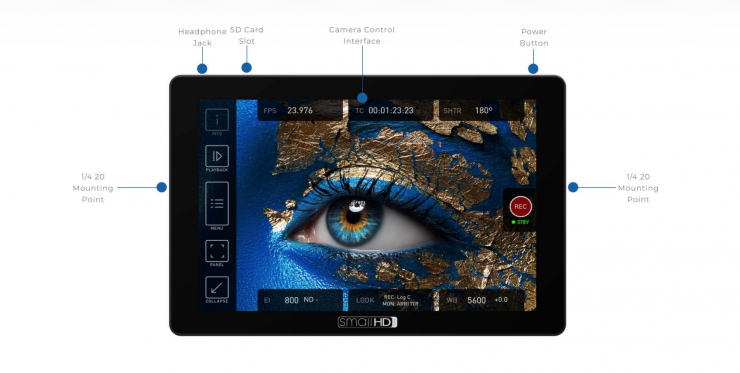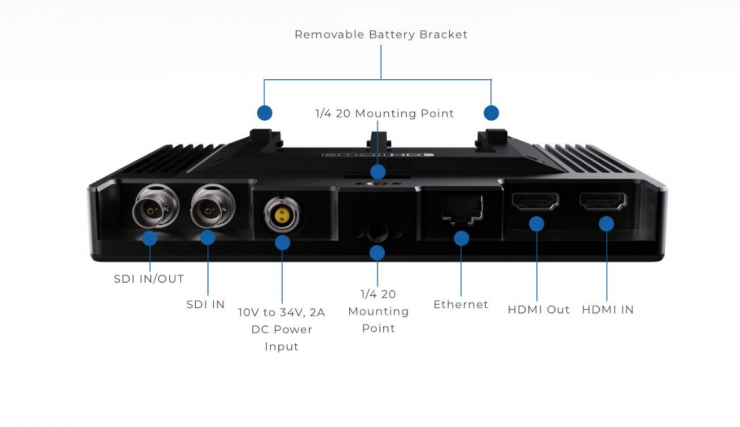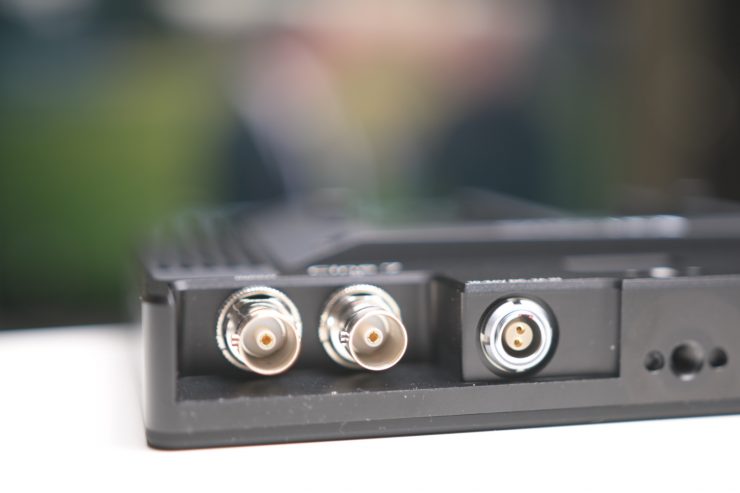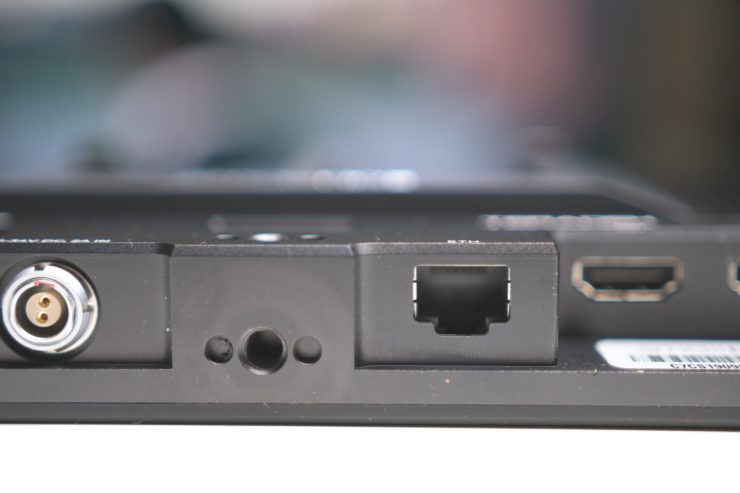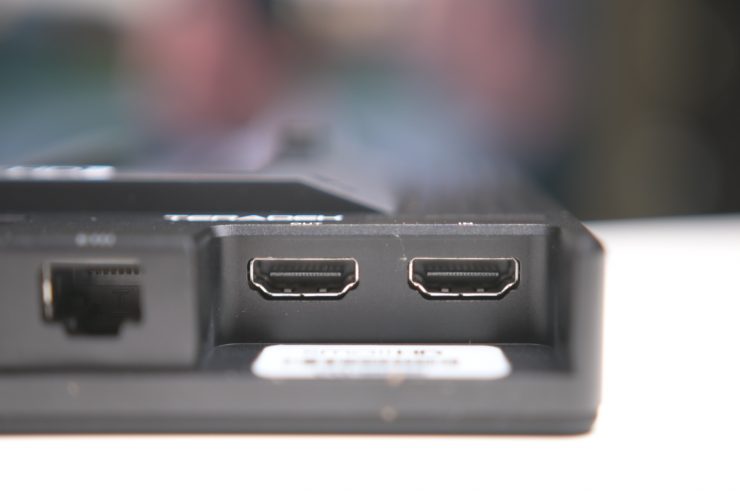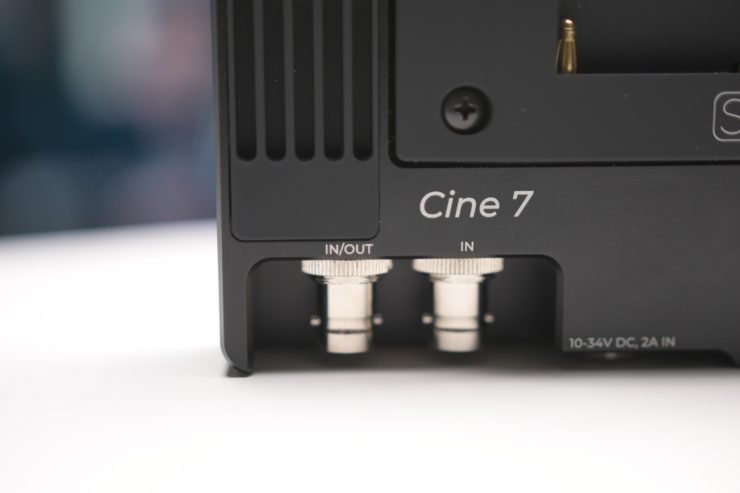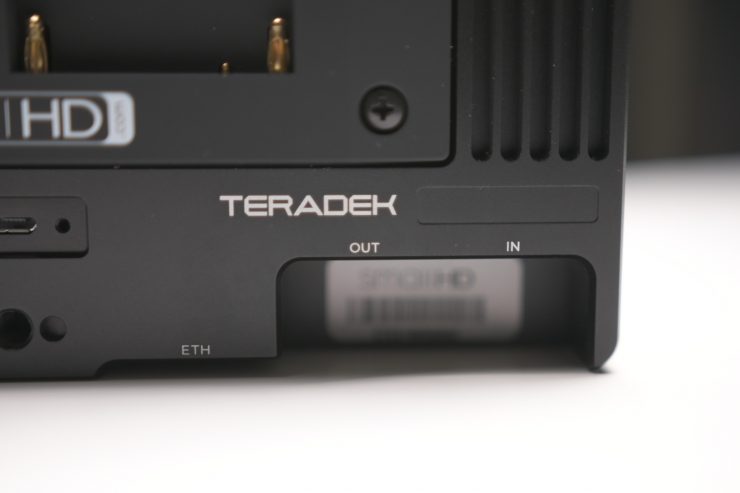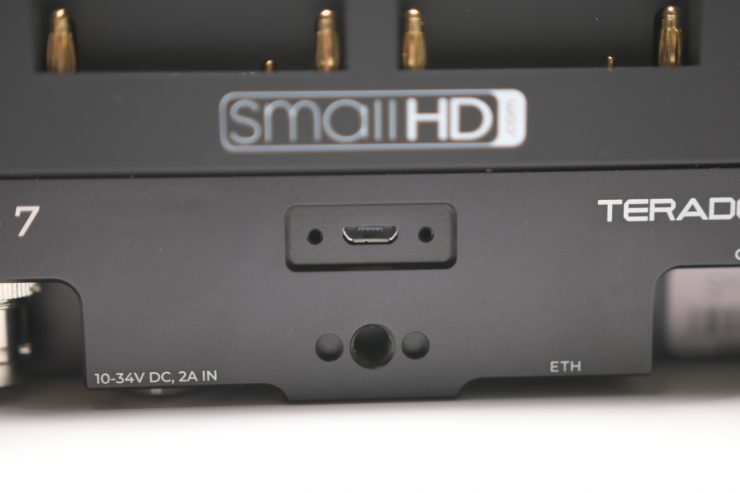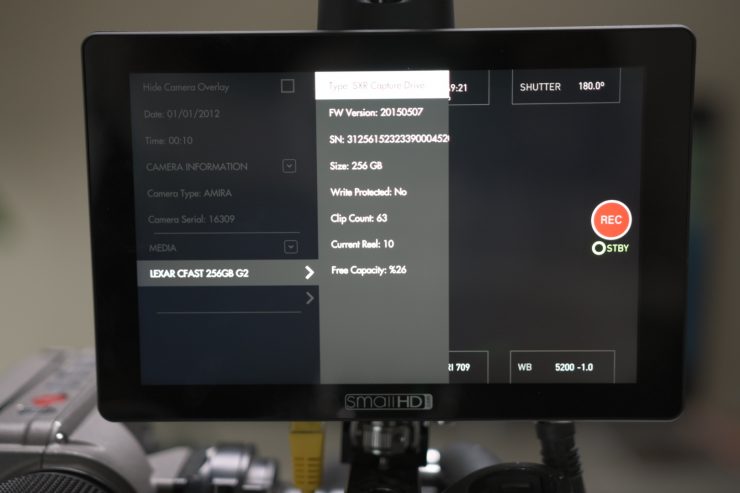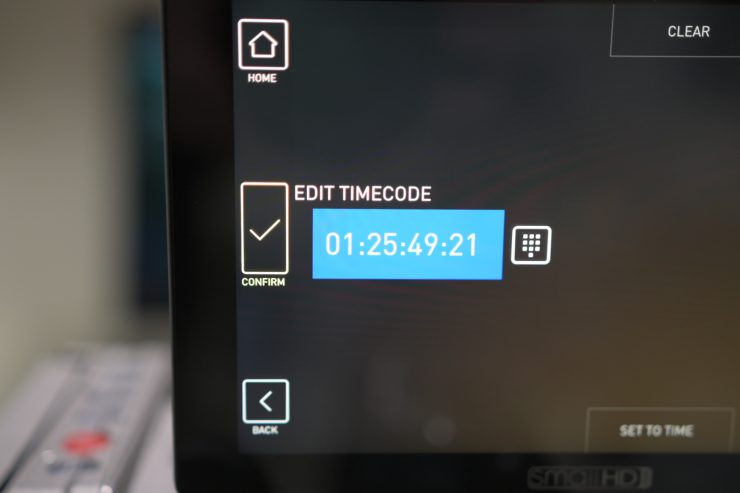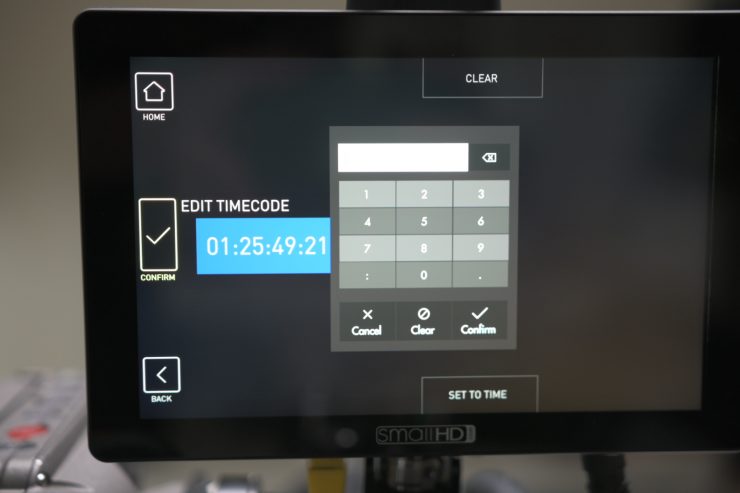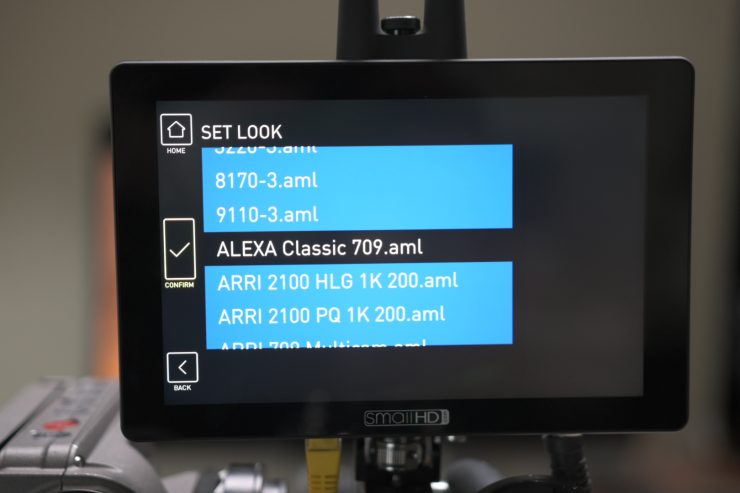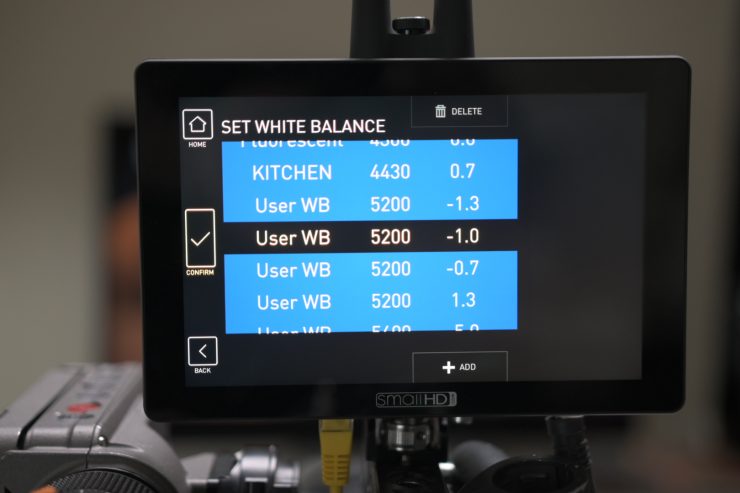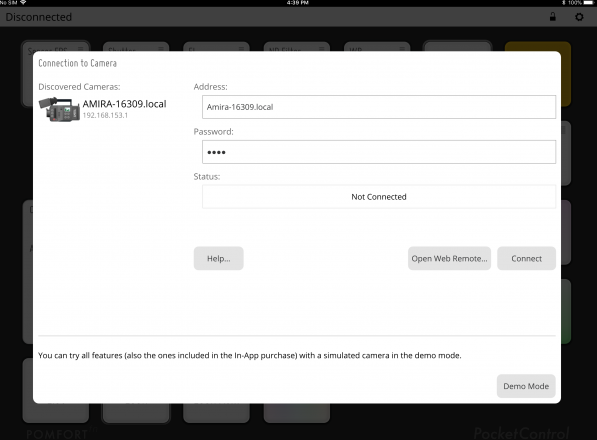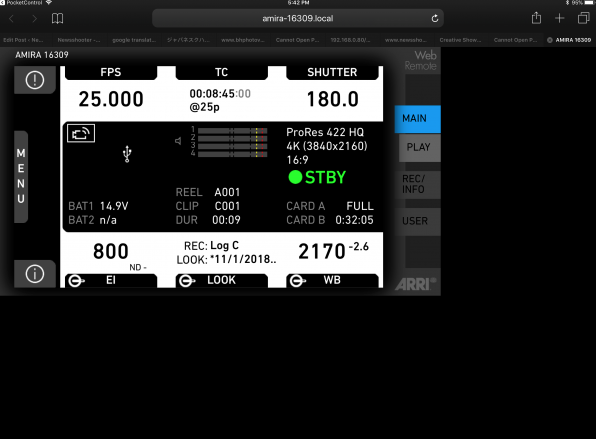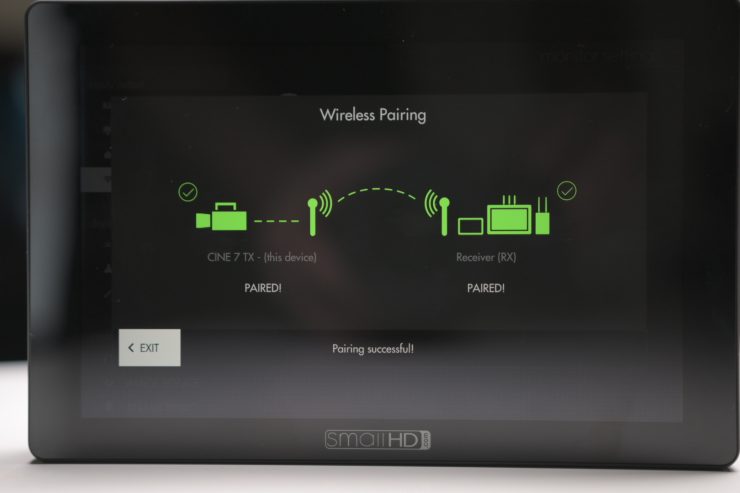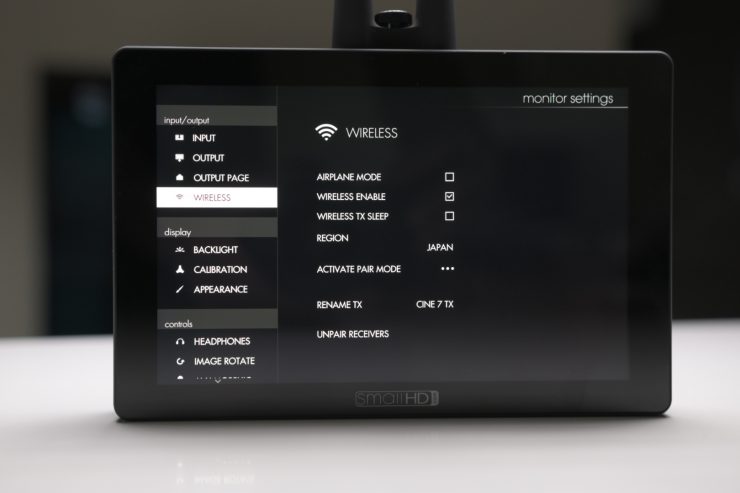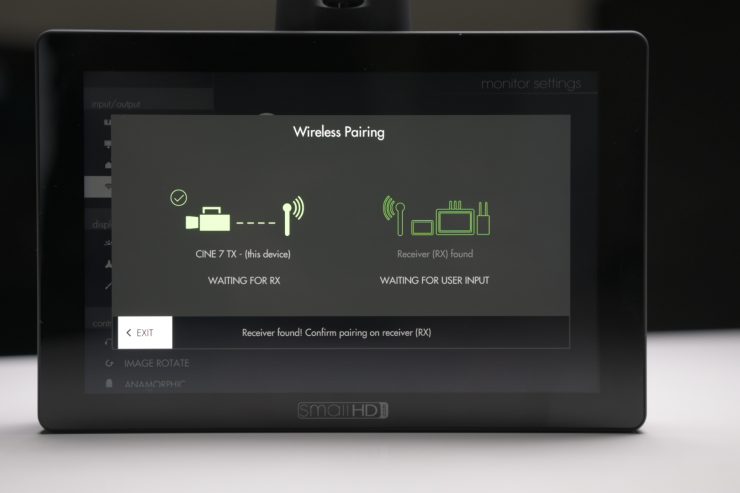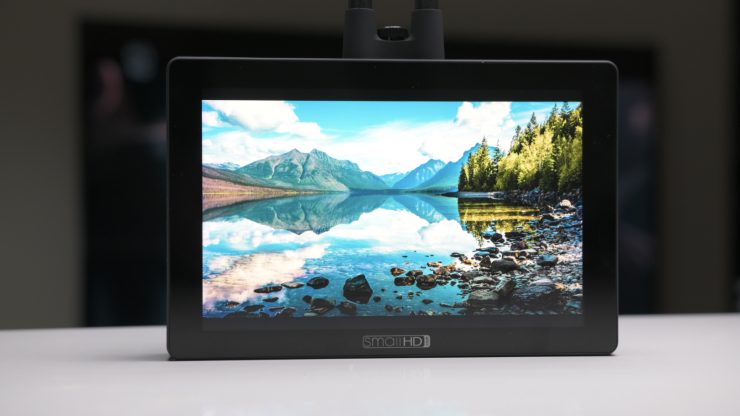
The SmallHD Cine 7 platform is based around a 1080p display with daylight viewable 1,800 nit display that offers 100% coverage of the DCI-P3 color gamut.
The SmallHD Cine 7 TX is a combination of a 7″ On-Camera Monitor and a Teradek Bolt 500′ transmitter. This new zero-delay 7″ wireless monitor leverages the best technology from both Teradek and SmallHD and combines it into a single product.
Not only does the Cine 7 have a nice display but the monitor can also directly control some cinema cameras. On launch, the monitor will be able to control the ARRI Alexa Mini, AMIRA & Mini LF as an optional license ($500), with support coming for RED & Sony later in the year.
The SmallHD Cine 7 500 RX and TX are based around the same concept as the FOCUS Bolt 500 RX/TX, FOCUS 7 RX/TX, and 703 Bolt.
The Cine 7 500 TX that I was reviewing is a pre-production version so some aspects may improve before it actually starts to ship.
Key features
- 7″ 1920 x 1200 Touchscreen Display
- Built-In Teradek Wireless Video Receiver
- Camera control (optional license)
- Transmits up to 1080p60 Video
- Up to 500′ Wireless Working Distance
- Waveform / RGB Parade / Vectorscope
- 1800cd/m² 10-Bit IPS LCD Panel
- Daylight-Viewable Display
- Dual, Hot-Swap L-Series Battery Plate
- Wireless lens data Olay’s (optional license)
- Shot Over integration menus
- 160° Viewing Angle
- Input: Wireless, 1 x 3G-SDI In, 1 x HDMI In, Ethernet, 10V-34V, 2A DC power input
- Output: ⅛” Headphone Jack, 1 x 3G-SDI In, 1x HDMI Out
I’ve owned a couple of SmallHD monitors over the years, dating all the way back to the original DP6. While I have always liked the form factor and build quality I have never been 100% happy with the color rendition. In saying that, there have been very few monitors I have come across that actually display accurate colors.
In the last year or so we have started to see some very good 5″ and 7″ monitors starting to appear. I recently reviewed the Atomos Ninja V and was very impressed by the screen quality and the accurate colors. I’m hoping the SmallHD Cine 7 will be even better.
How does the Cine 7 differ from the FOCUS 7?
So how does the Cine 7 compare against the FOCUS 7? Below you can see the key differences.
| Cine 7 | FOCUS 7 |
| Display: 7-inch, 1920×1200 322 PPI | Display: 7-inch, 1920×1200 323 PPI |
| Brightness: 1800 nits | Brightness: 1000 nits |
| Input: Wireless, 2 x 3G-SDI IN, (1 SDI can be used as a IN or an OUT 1 x HDMI In, Ethernet, 10V-34V, 2A DC power input | Input: HDMI, Micro USB |
| Output: 1 x 3G-SDI OUT, 1x HDMI OUTt, ⅛” Headphone Jack, | Output: ⅛” Headphone Jack, 7.2v Power |
| Power: 1×2 Sony L Series Battery, V-mount or AB-mount plates | Power: 1-2x Sony L Series Battery (Not Included) |
| Color Gamut: 100% DCI-P3 | Color Gamut: 75% DCI-P3 |
| Weight: 20oz (566.99g) | Weight: 13.6oz (385.55g) |
All-in-one solution
The whole philosophy behind the Cine 7 RX and TX is simplicity. By integrating everything you need into one compact solution you take away some of the pains of traditional wireless monitoring. You only need to power one device, don’t need to mount one product to another and you don’t need to run any cables. By keeping things simple, it allows filmmakers to spend more time actually creating, instead of worrying about equipment.
Who is it aimed at?
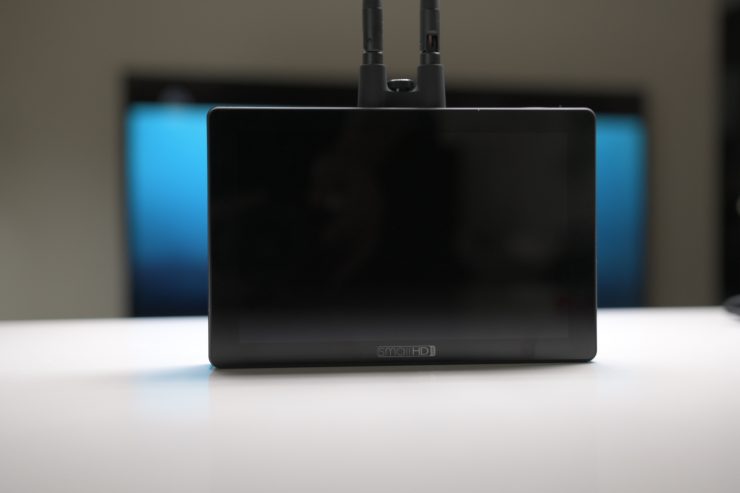
The Cine 7 RX and TX are being targeted at professional users who need a better solution than say a Focus 5 or Focus 7. The Cine 7 provides an all-in-one wireless monitoring and/or transmission solution.
The Cine 7 RX looks to be a good in-between solution for people who want a wireless monitoring solution that has a larger screen and more features than a Focus 7, but don’t want to go to the expense of buying a 703 Bolt.
When I asked SmallHD directly who the Cine 7 is aimed at they told me:
The Cine 7 series is aimed at anyone who wants a beautiful and versatile professional 7” camera monitor: AC’s for remote focus pulling, camera operators, solo shooters who need camera control and don’t have an assistant, directors who want a compact, lightweight but high-fidelity handheld monitor
SmallHD
Shooters working on high-end factual productions will often get requests to provide a wireless monitoring solution as part of their kit. The Cine 7 RX and TX would be a good solution for this very reason.
You could also use it as on-camera monitor whenever you don’t need to provide a wireless video system. In some ways, this makes a lot of sense because you can use it for multiple purposes.
What does it come with?
The Cine 7 500 TX ships with the following items:
- Lemo to D-tap cable 36″
- 8GB SD card
- SmallHD cleaning cloth
The Cine 7 500 RX ships with the following items:
- Sony L Series Battery Bracket for 702 Touch and CINE 7 Series
- Monitor Handles + Neck Strap
- L-Series Battery Kit with Interchangeable AC Plugs
- 8GB SD card
- SmallHD cleaning cloth
Function over flash
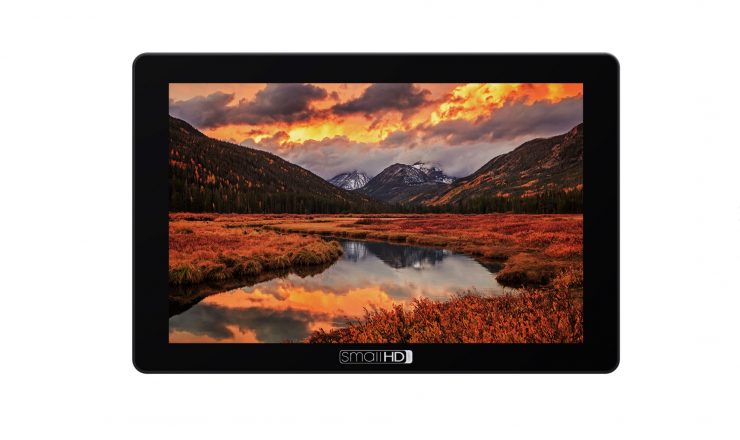
Cine 7 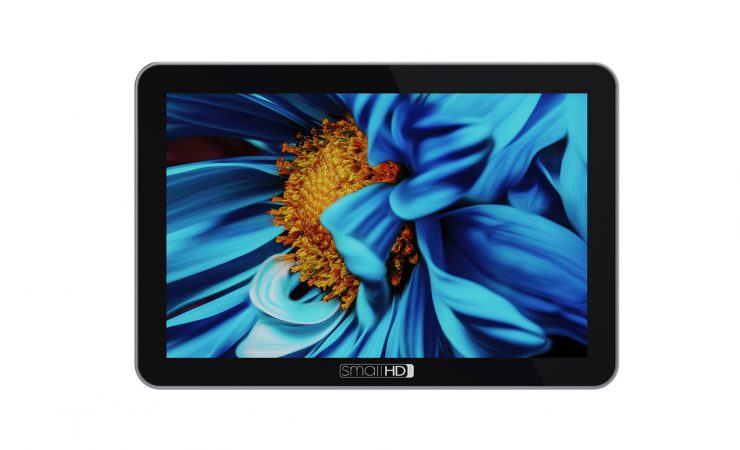
Focus 7
Appearance wise the Cine 7 series looks fairly similar to a FOCUS 7 series. The black finish and understated design again point to the philosophy of keeping things clean and simple. Wireless video and monitoring solutions need to be well made and stand up to the rigors of field use.
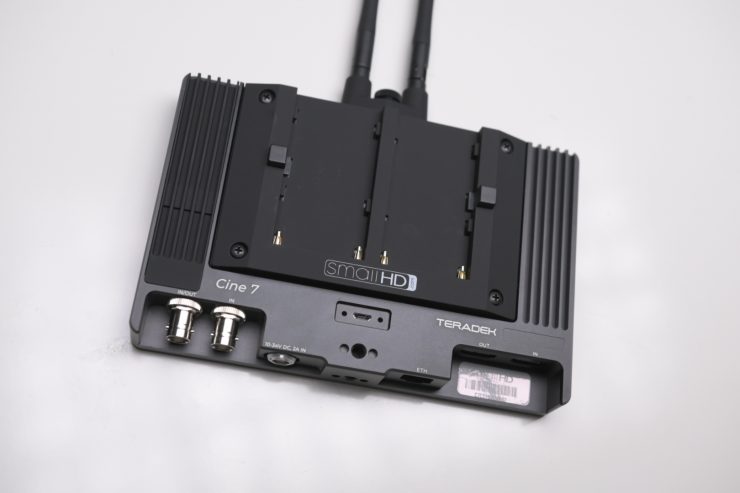
The external housing of the Cine 7 is made out of milled aluminum. The build quality of the Cine 7 is excellent. Everything from the battery plate to the connectors to the overall finish has been well thought out and executed.
There are plenty of mounting points. There is a 1/4-20″ on each side of the unit, one on the bottom, and one on the back. Unfortunately, it doesn’t use the ARRI standard accessory mount but there are pin-locs.
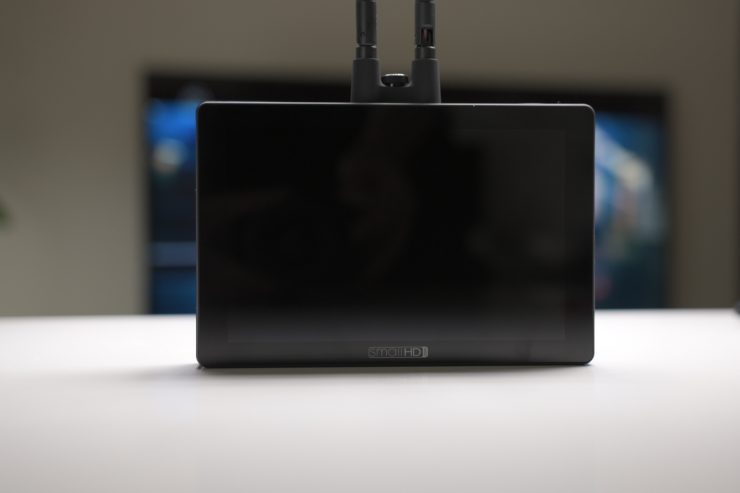
The weight of the Cine 7 RX and TX is 20.6oz (584g).
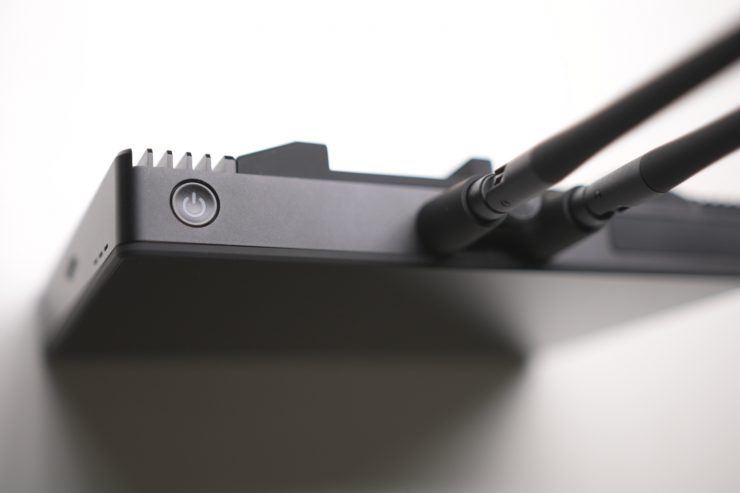
The only button on the Cine 7 is a power button. There are no other switches or buttons on the unit at all.
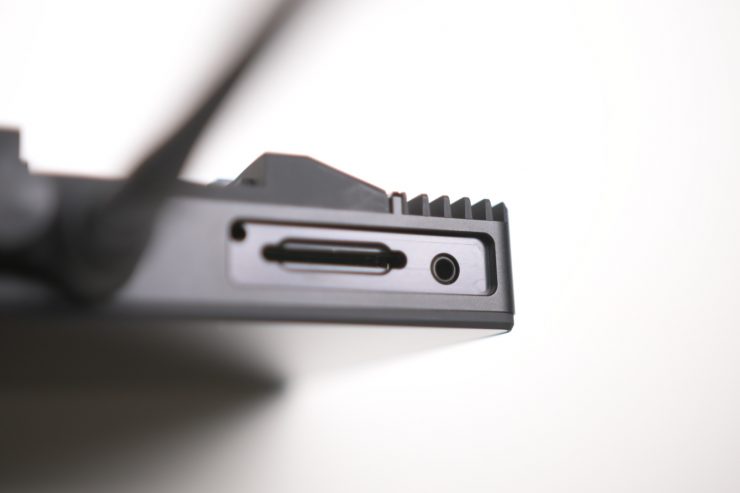
On the opposite end from where the power button is located, there is the SD card slot as well as the headphone jack.
On the bottom of the Cine 7 you will find recessed SDI IN and SDI IN/OUT ports, the HDMI IN and HDMI IN/OUT ports, the ethernet port, and the 2 pin Lemo power input. The Cine 7 does cross conversion between SDI and HDMI and HDMI and SDI.
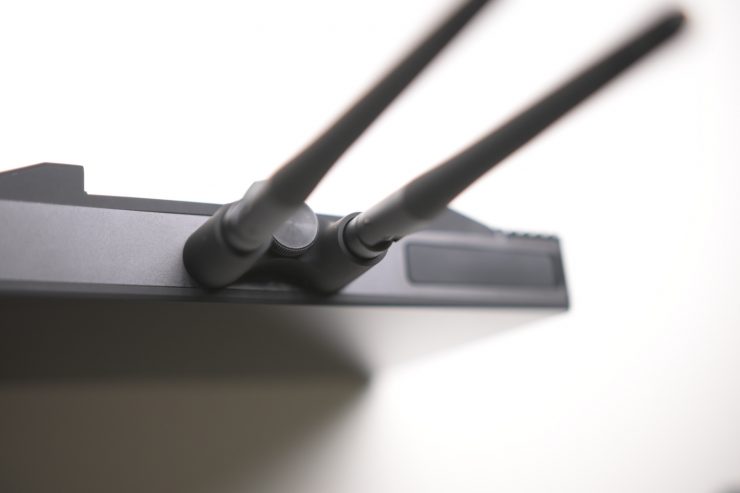
On the top of the Cine 7 RX and TX, there are two removable wireless antennas.
Heat
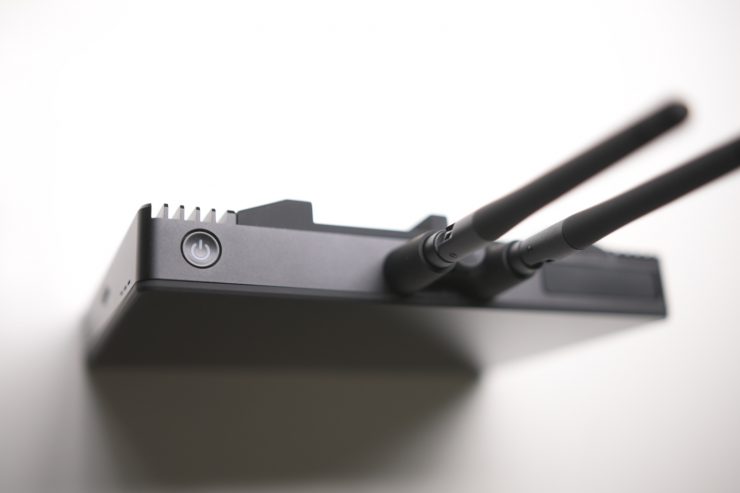
There is a lot going on with the Cine 7 TX. With an 1,800 nit display and built-in wireless transmitter or receiver, there needs to be some way of keeping everything cool.
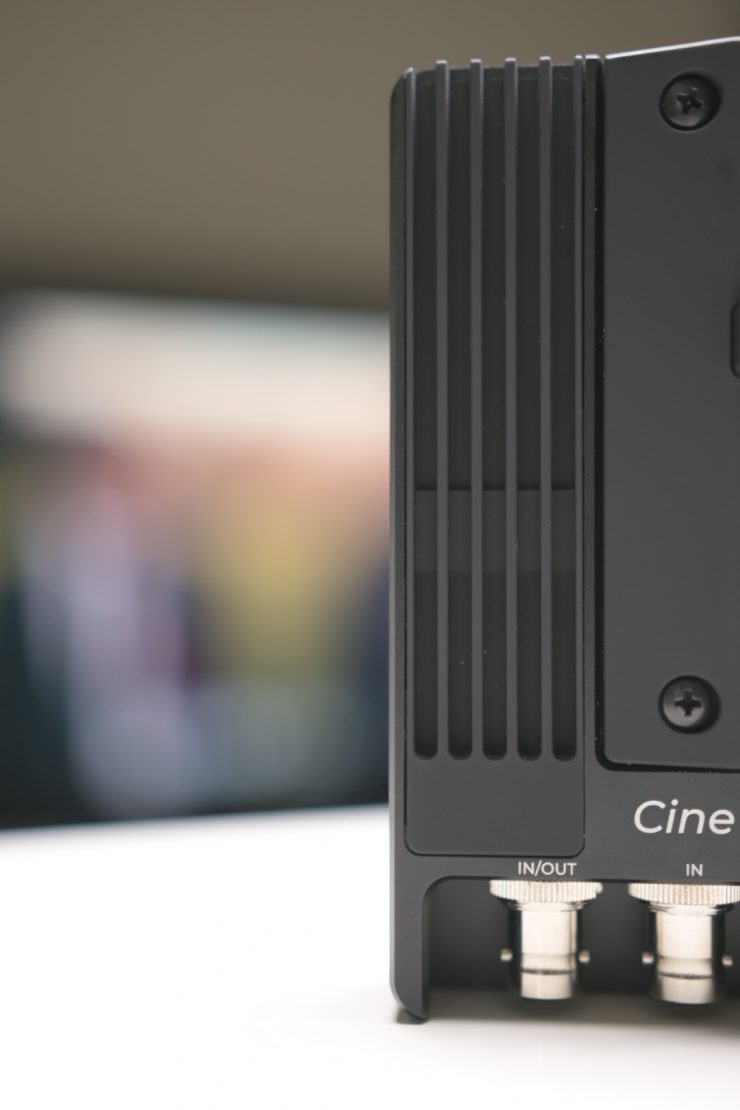
The Cine 7 versions don’t have a fan and instead use heat sinks. The benefit of this is there is absolutely no noise, the downside is the unit does get hot, very hot. Once it has been on for a while you can’t touch the edges of the monitor where the heat sinks are. This for me is the biggest downside of the Cine 7. As the version I was reviewing is still a pre-production unit I asked SmallHD about the heat. They told me that they are still working on cutting down the amount of heat that the Cine 7 produces.
In all honesty, I would prefer a bit of heat over a noisy fan that interferes with the recording of audio.
Form factor
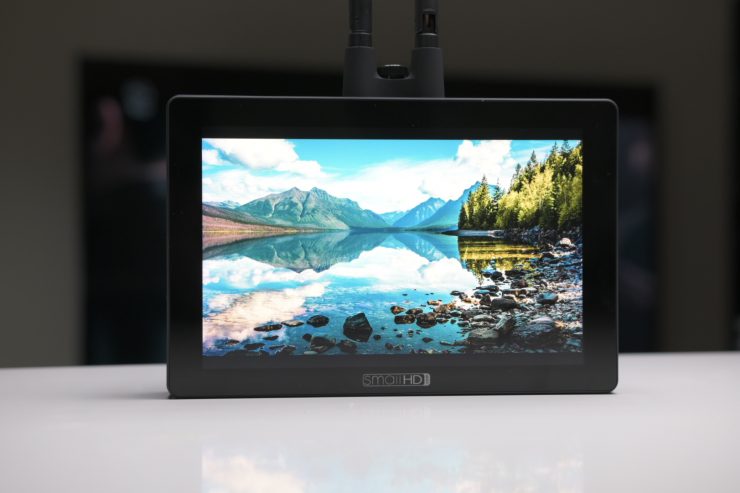
If you are going to build a product that is primarily designed to be used on a camera then it not only has to be functional but also easy to mount.
The Cine 7 500 TX is relatively easy to mount but if you are using the ethernet port for camera control you may not be able to attach some mounts or arms to the bottom of the monitor. I found that if I used a SmallRig mount and attached it to the bottom 1/4-20″ mounting point I wasn’t able to insert the ethernet cable into the monitor.
Is the screen bright enough?
One of the biggest selling points of the Cine 7 is the 7″ (17.8cm) 1,800 nit daylight viewable 1920×1200 IPS LCD screen, which uses an optically bonded anti-reflective screen. Optically-bonded Gorilla Glass has been used because of its transparency and toughness. The optical bonding process is supposed to reduce the harshness of reflections and make sure that blacks are not washed out.
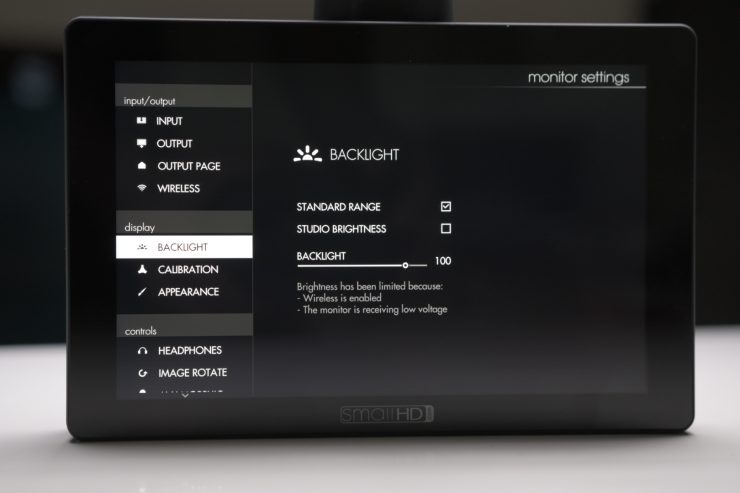
At 1,800 nits, the Cine 7 is significantly brighter than the FOCUS 5 (800 nits), Focus 7 (1000 nits), but
I personally think that 1,800 nits
I actually found that in real world use the screen was bright enough to be used outdoors, even in direct sunlight. It certainly helps that the screen isn’t super reflective.
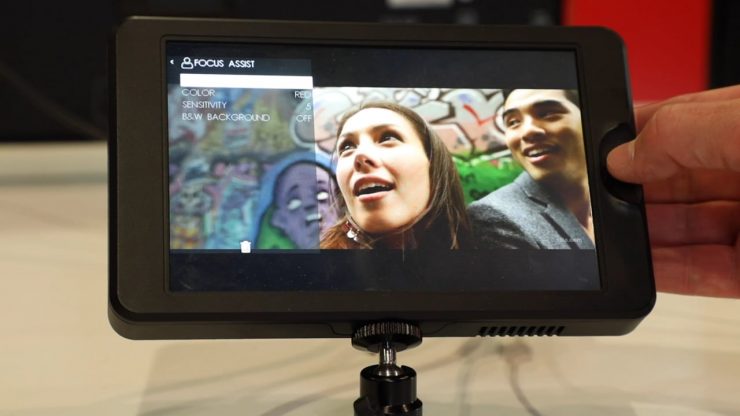
There are a lot of new 7″ monitors coming to the market such as the SWIT T7 and G7 (3,000 nits), TV Logic F-7H II (3,600 nits), and the Portkeys BM7 (2,000 nits). Just like higher resolution doesn’t always equate to a better camera, higher nits doesn’t always equate to a better monitor.
The pixel density is a claimed 323 PPI. The panel is listed as 8-bit with 10-bit scopes. A lot of companies list their monitors as 10-bit even though they are really using a 10-bit (8+2 FRC) panel. FRC stands for Frame Rate Control Technology and an 8+2 FRC panel is basically a way of trying to approximate the color reproduction of a true 10-bit panel. A true 10-bit monitor can display 1024 shades of color, whereas a 10-bit (8+2 FRC) panel can only truly display 256 shades. So what a 10-bit (8+2 FRC) panel does is artificially create in-between shades of color by quickly shifting the pixels to go between certain shades of colors.
For example, you would show the main shade of one color for 75% of the time and then another one for 25% of the time. This creates an illusion for the viewer that they are actually seeing more colors than what can actually be displayed.
Image quality
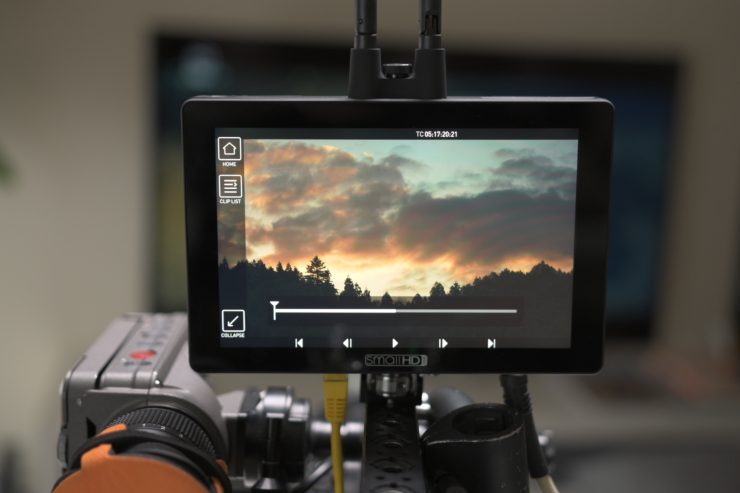
At the end of the day if a monitor can’t display accurate images then it doesn’t matter how many bells and whistles it has.
The picture quality is really good on the Cine 7 and I think most people will be happy with it. I haven’t used every SmallHD monitor they have made, but personally, I found the image quality on the Cine 7 to be right up there with the best I have seen from any monitor with more than 1,500 nits.
Quite often I have found that most high bright monitors are a compromise between brightness and image quality. I found this to be the case with the 3,000 nit 703 Bolt. The Cine 7 strikes a very good balance between image quality and brightness.
The colors are nice and vivid and most importantly the blacks look nice and black. Even at 1,800 nits the Cine 7 retains good contrast and color rendition. Most importantly the colors I was seeing on the Cine 7 looked almost identical to those of my EVF. A lot of monitors tend to be overly saturated and at first glance, they look great, but a good looking image doesn’t mean that it is accurate.
The trouble with trying to evaluate any monitor’s image quality is that it is very subjective. What one person may think looks good, another may think it looks terrible. For me personally I wan’t the monitor to match as closely to what I am seeing in my cameras EVF.
Does accuracy really matter?
This may sound like a riduculous question to ask, but with everyone watching content on differnt screens and types of screens, it’s a legitimate question.
Just because you are basing color accuracy, brightness, and contrast off whatever monitoring or grading monitor you are using there is very little chance that it is going to be seen by someone as intended unless it happens to be shown in a movie theatre (and even then there is still variables).
In the case of giving a monitor to a director, producer, or client, does it really need to be super accurate? That answer is really going to depend on the level of production. For me personally, I would rather try and provide the best image possible so that a director, producer, or client knows exactly what they are getting. I found that the image from the Cine 7 enabled me to show producers, directors or clients a fairly accurate indication of what they were getting.
Real world use outdoors
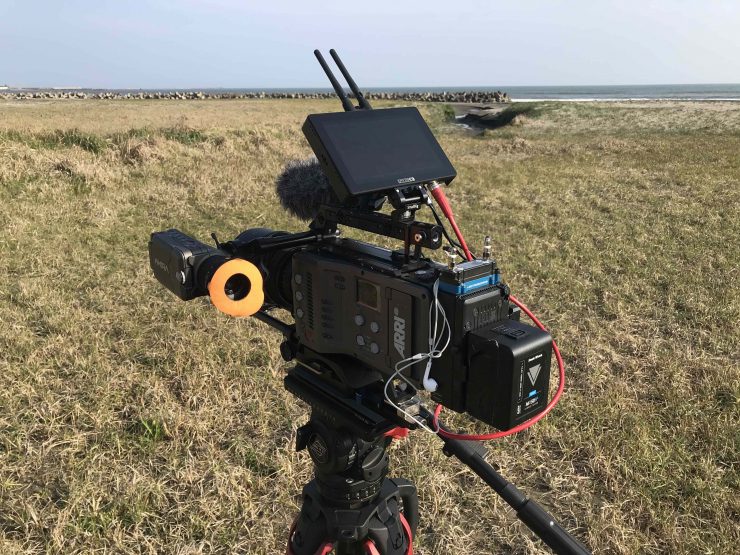
Most monitors will look good indoors, but outdoor usability is what separates a great monitor from a good monitor. Too often I have tested so called “Daylight viewable” monitors only to find out they can’t be used outdoors.
So how does the Cine 7 perform outdoors in sunny conditions? As I previously mentioned, I had no problem using the Cine 7 outdoors, even in direct sunlight.
Is it actually 1,800 nits?
To check the claimed brightness of the Cine 7, I shot a white card with a light set at 5600K, and then exposed the image so it was just below 100% so there was no clipping. I then took a reading from the Cine 7 using a Sekonic C-800. The Cine 7 has a claimed maximum brightness of 1,800 nits so does it produce 1,800 nits?
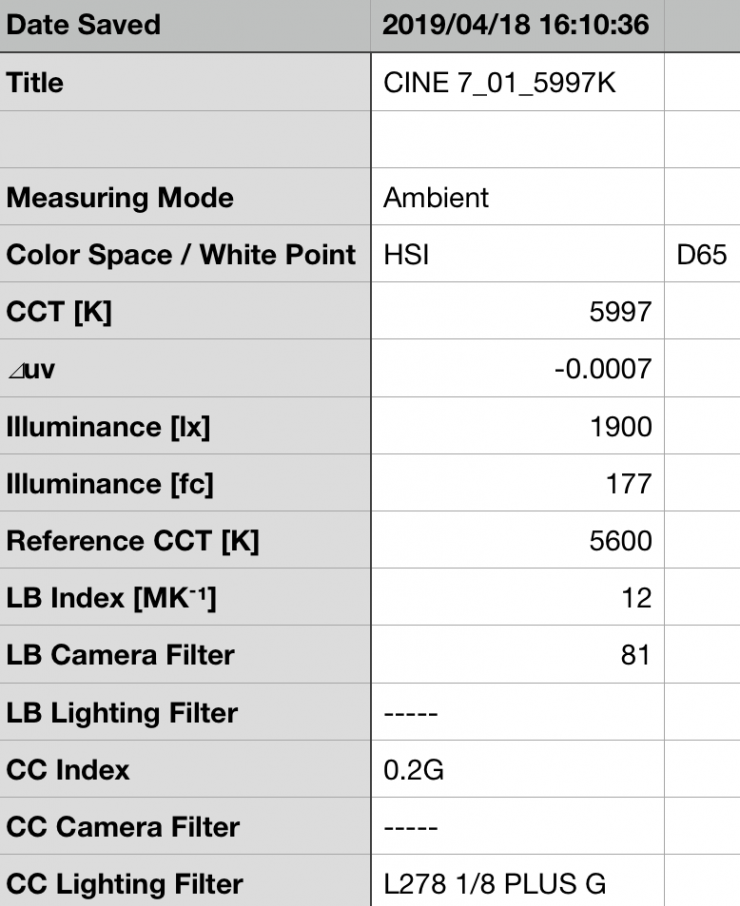
The Cine 7 gave me a reading of exactly 1,900 lux and a Kelvin color temperature reading of 5997K. Just for reference, it had a CC score of 0.2G. The reading of 1,900 lux exceeds SmallHD’s figure of 1,800 lux.
How does the picture quality compare to an Atomos Shogun Inferno, Ninja V, and a SmallHD Focus 7?
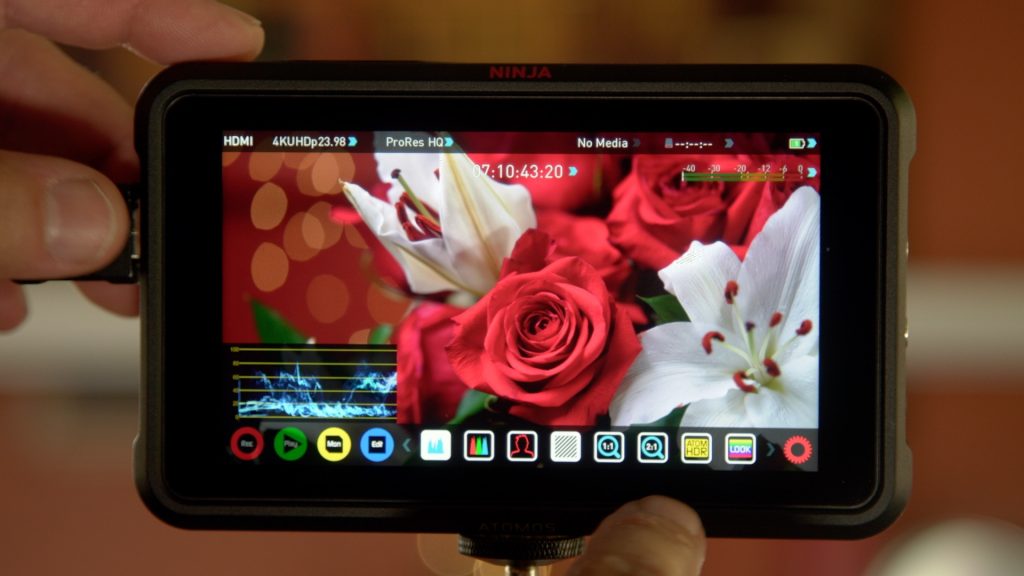
Even though the SmallHD and the Atomos products are designed for completely different purposes they are both still monitors so I wanted to see how the image quality compared. I did this comparison because I have access to these monitors.
The Atomos Shogun Inferno is 1,500 nits which is slightly less than the Cine 7’s 1,800 nits. The Shogun Inferno ($999 USD) is half the price of the monitor only Cine 7 ($1,799 USD).
The Ninja V and Shinobi both have 1,000 nits, as does the SmallHD Focus 7.
I quite like the screen on the Shogun Inferno, but the noisy fan makes it unsuitable for use as an on-camera monitor for interviews or where sound recording is critical. The Ninja V and the Shinobi both have a really nice screen and the fan noise is a lot less prevalent than the Shogun Inferno.
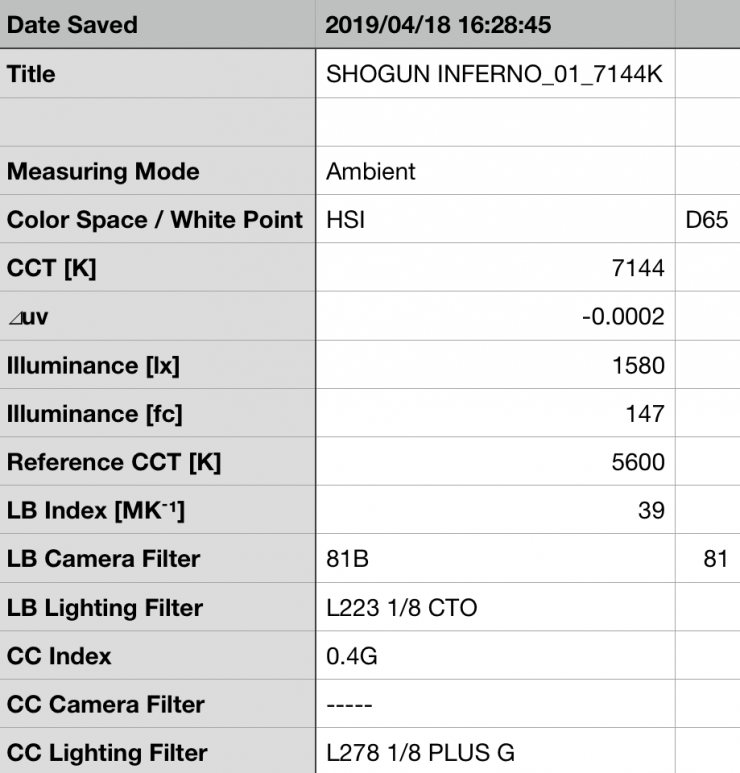
To check the claimed brightness of the Shogun Inferno, I shot a white card with a light set at 5600K, and then exposed the image so it was just below 100% so there was no clipping. I then took a reading from the Shogun Inferno with a Sekonic C-800. The Shogun Inferno gave me a reading of 1,580 nits and a Kelvin color temperature reading of 7144K. It had a CC score of 0.4G.
In summary here is how the Cine 7 and Shogun 7 compare when you look at brightness, Kelvin color temperature, and CC score. Just for another reference, I have thrown in the Atomos Ninja V and the SmallHD Focus 7.
| SmallHD Cine 7 | 1,900 lux | 5997K | CC 0.2G |
| Atomos Shogun Inferno | 1,580 lux | 7144K | CC 0.4G |
| Atomos Ninja V | 1,070 lux | 5697K | CC 0.2G |
| SmallHD Focus 7 | 1,170 lux | 6489K | CC 0.1G |
On the SmallHD monitors you can set the white point to various Kelvin color temperatures. For the above readings the SmallHD monitors were set at D65 (6500K).
Below you can see where the various Kelvin color temperatures fall.
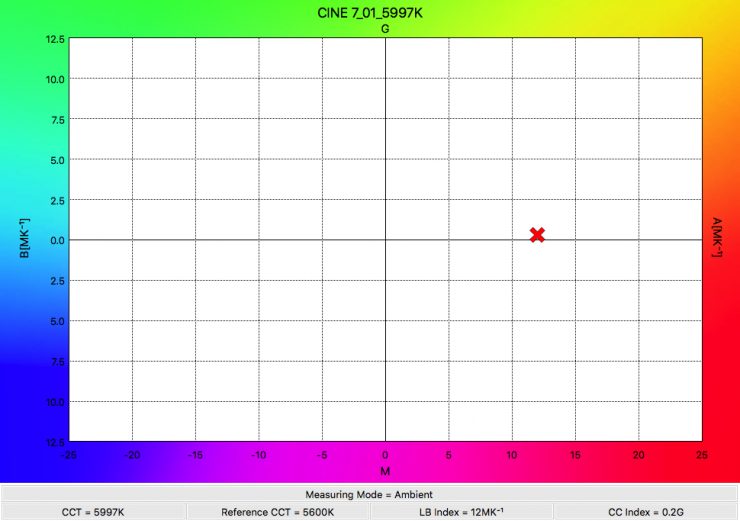
SmallHD Cine 7 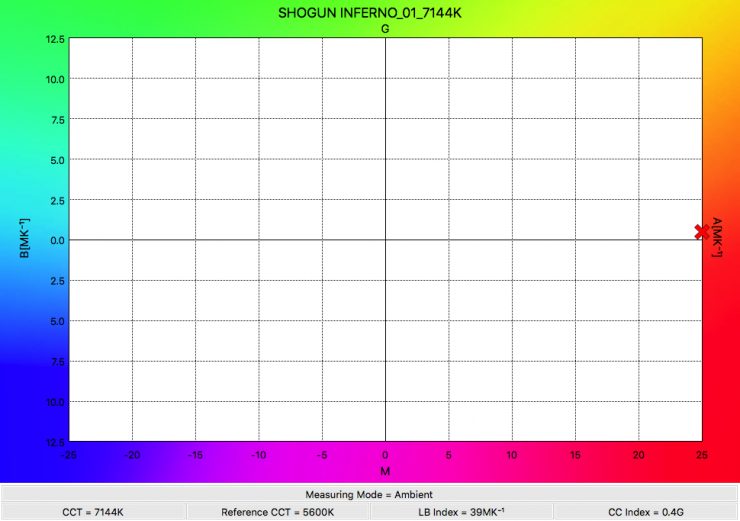
Atomos Shogun Inferno 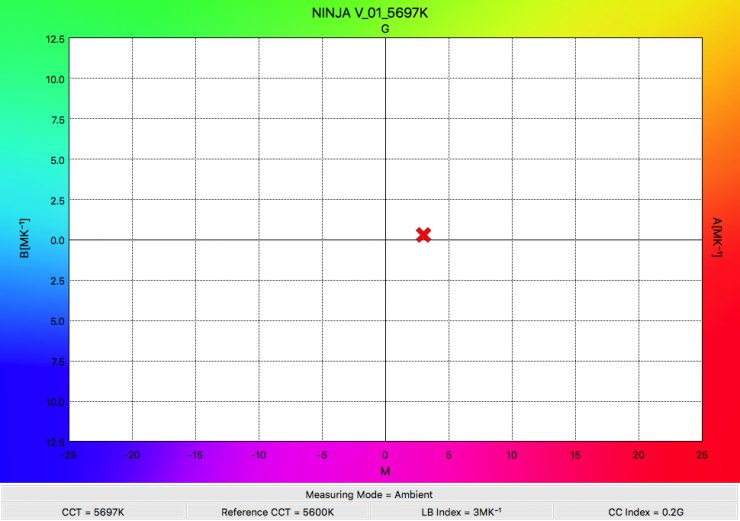
Atomos Ninja V 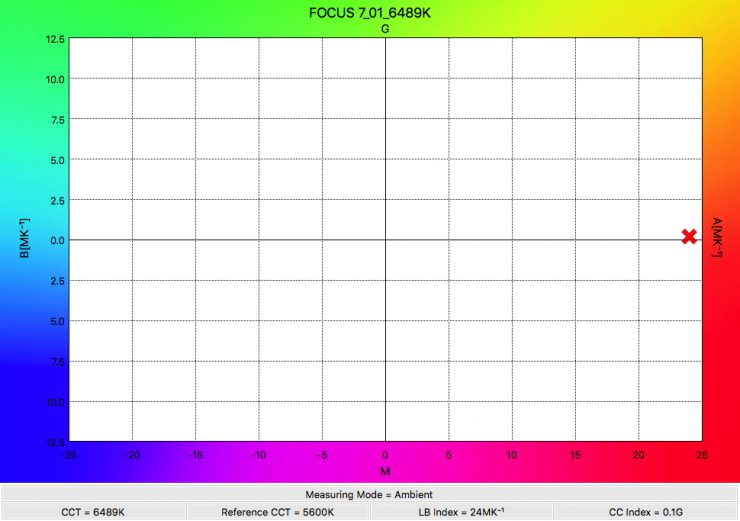
SmallHD Focus 7
Measurements are one thing, but how do all of these monitors actually compare in the real world? Well, I found that the SmallHD Cine 7 had the most neutral looking image of all three. The Atomos Ninja V had the most detail (although that is due to the smaller sizes and higher 427 PPI). I always find that the Atomos monitors are a little bit over saturated. The Shogun Inferno still looks pretty good but it’s showing its age when compared to the newer displays being used on the Cine 7, Ninja V, and Focus 7.
The screen on the Cine 7 is not nearly as glossy as both the Ninja V and Shogun Inferno and that makes it far easier to see outdoors.
It will be interesting to see how the Cine 7 compares against the recently announced Atomos Shogun 7 ($1,499 USD).
All of these monitors can be calibrated through the use of X-Rite products.
Touch screen
The Cine 7 series all feature touchscreen control. Touchscreen control is great, but it also needs to work when you are using gloves in cold conditions.
The touchscreen, for the most part, is nice and responsive. I only found myself very occasionally having to press something more than once to get it to work.
While I do like the touchscreen functionality you do need to be aware that you will have to constantly wipe the screen with a cleaning cloth due to how many fingerprint marks will accumulate on the display.
Power up time
I hate monitors or products that take too long to boot up before you can use them. The Cine 7 boots up very quickly. I timed it at about 3 seconds from the time I turned it on till I got a picture up on the screen.
PageBuilder OS
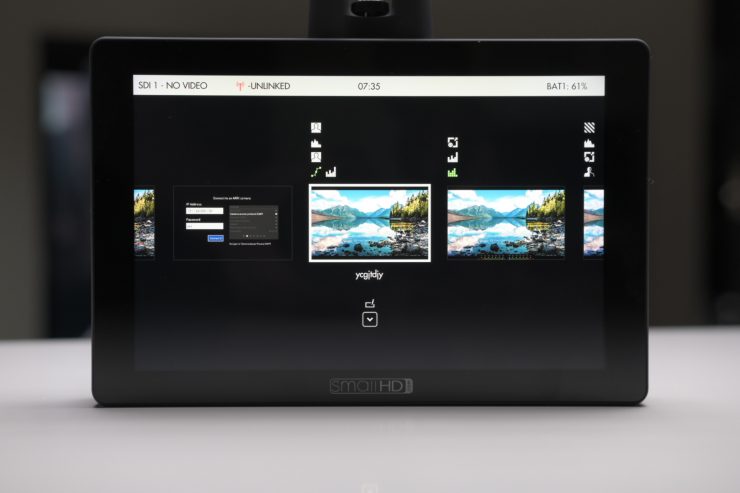
Like all SmallHD monitors, the Cine 7 uses the same PageBuilder OS graphical user interface (GUI). SmallHD built the PageBuilder OS to make menus less confusing. PageBuilder is a very customizable system as it allows you to selectively apply monitoring tools such as waveform, vectorscope, multiview, LUTs, and focusing aids on different “pages”. These pages can be easily flipped by using the touchscreen capabilities.
If you haven’t used a S
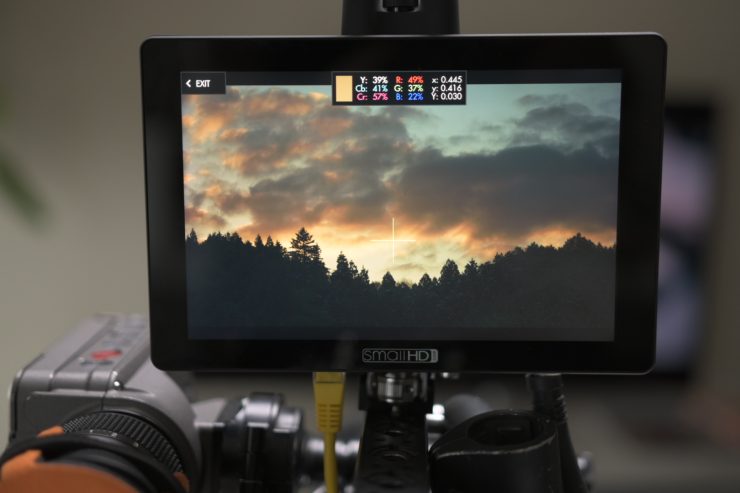
I really like PageBuilder OS. I find it by far the easiest operating system to use on any monitor. I especially like the Color Picker function where you can move a target icon around and it will display color values for you.
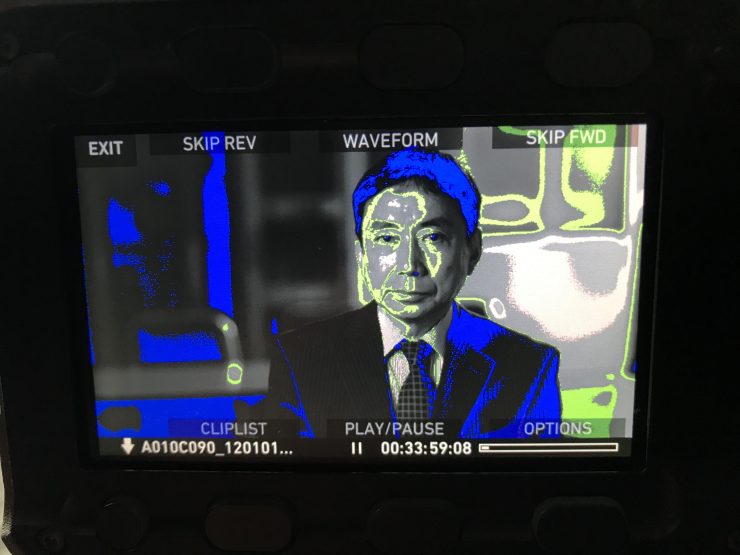
False color display in the ARRI EVF 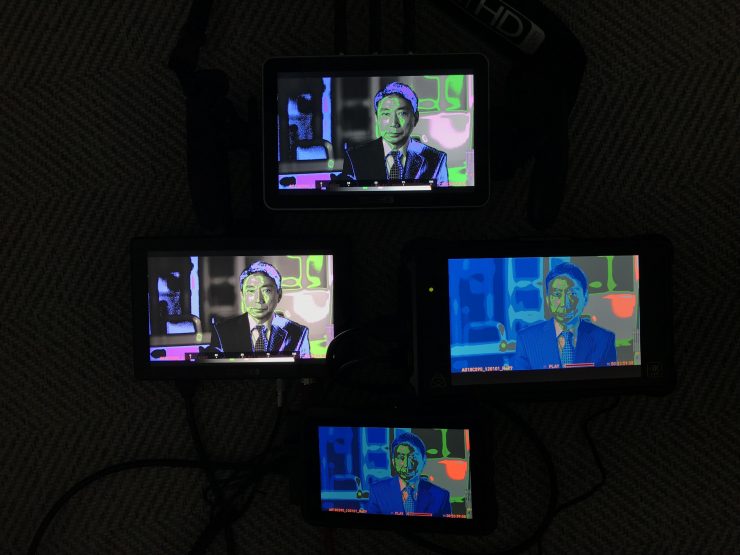
SmallHD (top & left), Atomos (right & bottom)
One of the other nice aspects of PageBuilder OS is that SmallHD has actually bothered to standardize the false color functionality. As a default, the false colors are mapped directly to ARRI cameras, but you can also customize them to whatever camera you are using. This is a big deal. A lot of other monitors just have false color with no scale or markings and you have no idea what you are actually seeing. Above you can see what I mean. The false color indicators on the SmallHD accurately reflect what I am seeing in my EVF.
Camera control
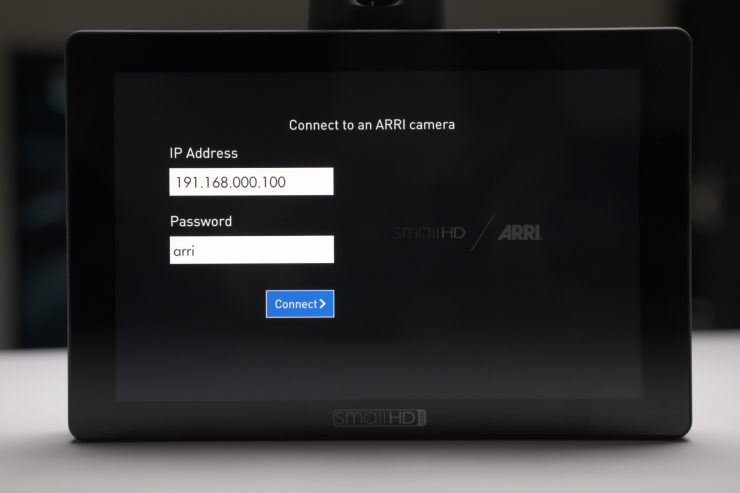
Normally when using the ARRI ALEXA Mini, ALEXA Mini LF, or AMIRA, you have to control the camera through the EVF, a web browser, or through something like Pomfort Pocket Control. With the Cine 7, you can make adjustments directly on the monitor, which is especially handy when the camera is mounted on a Steadicam, camera car or another rig setup.
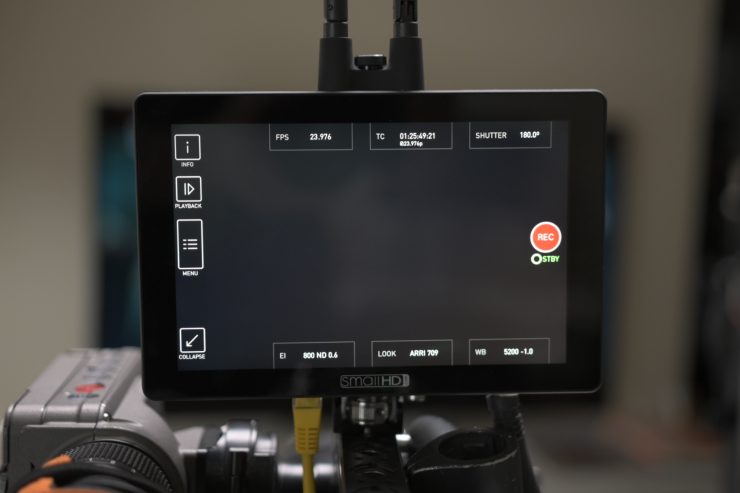
The Camera Control Menu appears as an overlay on the video feed once assigned to a Page. Each Page gives the user quick access to sets of tools (framing, exposure, focus, etc). Operators can toggle from Page to Page via the touchscreen interface.
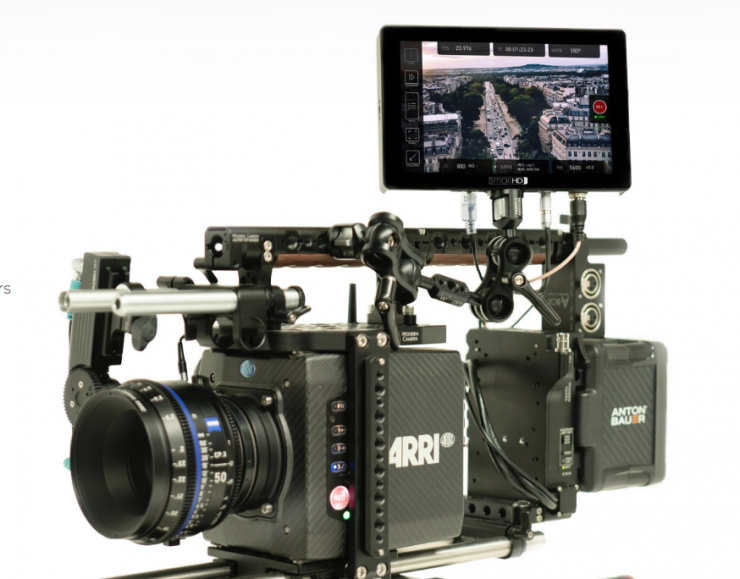
The Cine 7 has an ethernet port which is used to communicate with a compatible camera. Currently this only works with the ARRI Amira and ALEXA Mini. SmallHD will be adding support for RED & Sony cameras (not all models) later in the year.
This all does come at a cost. The license for camera control is $500 USD which is certainly a steep price to pay considering you can obtain the same functionality on your smartphone or tablet for free. I wanted to know what the rationale for charging a user $500 USD for a license was so I asked SmallHD. Here is what they said:
Software development for each camera is time consuming and therefore expensive. We have to do custom work for every single camera. If you want something to work with ARRI, it requires an incredible amount of time and energy, not to mention all the relationship building with ARRI. In addition, everything that works with ARRI is premium and that comes with a high price tag.
SmallHD
Customers will have to buy individual camera control licenses for other cameras, but SmallHD is working on a way to sell a bundle that will support “all future camera control capabilities” (i.e. pay X amount and get all future licenses).
For me personally, I think the camera control makes more sense when using the ALEXA Mini or Mini LF than the AMIRA. With the AMIRA, it is fairly easy to make changes directly on your camera, but on the ALEXA Mini, you need to do it through the EVF.
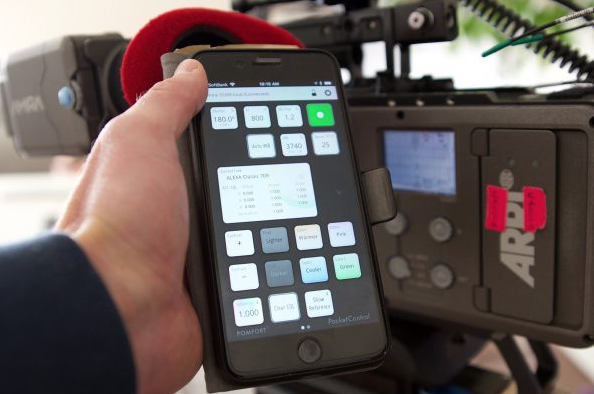
I can already make changes on my AMIRA through a smartphone or tablet, so why would I need camera control on a monitor? That is a good question! The first reason is that I can eliminate having to use another device. I don’t need to fire up my smartphone or tablet, join the cameras WiFi network and then open an app. As the camera control on the Cine 7 is done via ethernet, once it is connected and configured it will always be accessible every time you turn the camera and monitor on.
As it is being done via ethernet there is no delay and there is no chance of losing the connection.
By taking away the need for having to use a smartphone or tablet for camera control it certainly simplifies things.
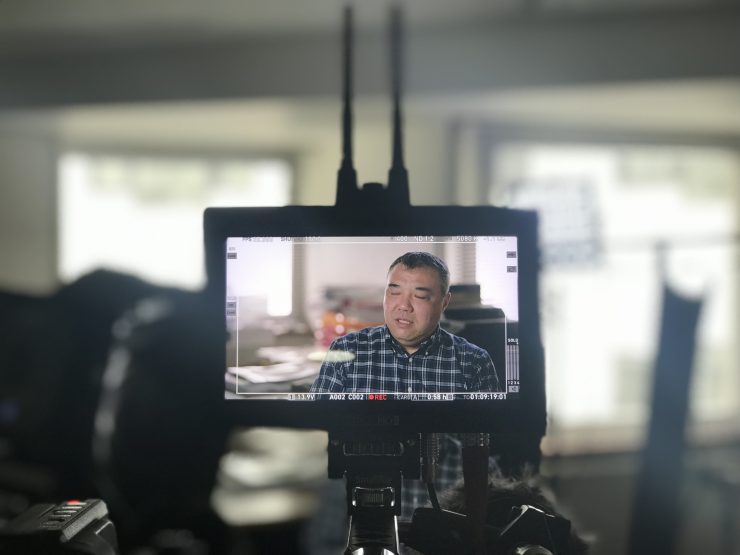
Often when shooting long interviews I don’t want to be hunched over an EVF and prefer to use a monitor. By having the camera control available on the Cine 7 I can change things quickly and also start/stop the recording.
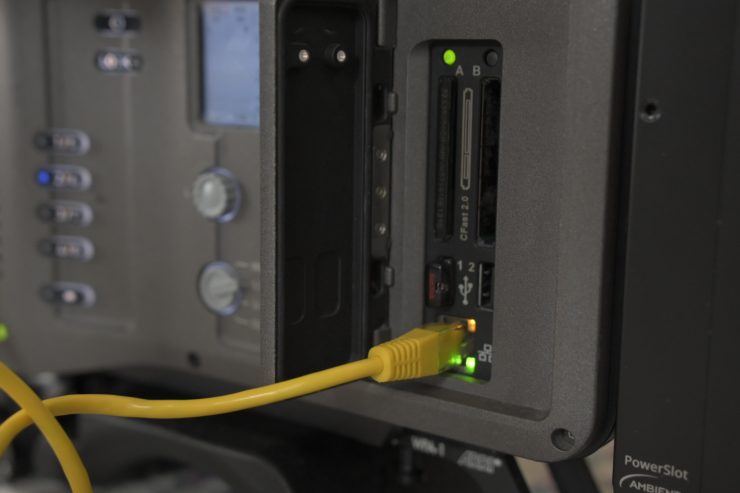
Now, there are some caveats. If you are using an ARRI AMIRA the ethernet port is located behind the media door so the door has to be open to use it. This is fine for interviews on a tripod but unusable if you had the camera on your shoulder.
The other problem with the camera control on the Cine 7 is what you can change is extremely limiting. You don’t have access to all of the menus of your camera and you are limited to only making changes to things like frame rate, white balance, LUTs, shutter speed, etc.
If you use the free ARRI web browser or Pomfort’s Pocket Control you can access every menu item and make changes.
This for me is what makes the $500 USD license fee for camera control on the Cine 7 a tough pill to swallow. If you were able to have the same functionality that is available if you use the web browser then I could maybe see the value, but with the limited camera control, It should be considerably cheaper.
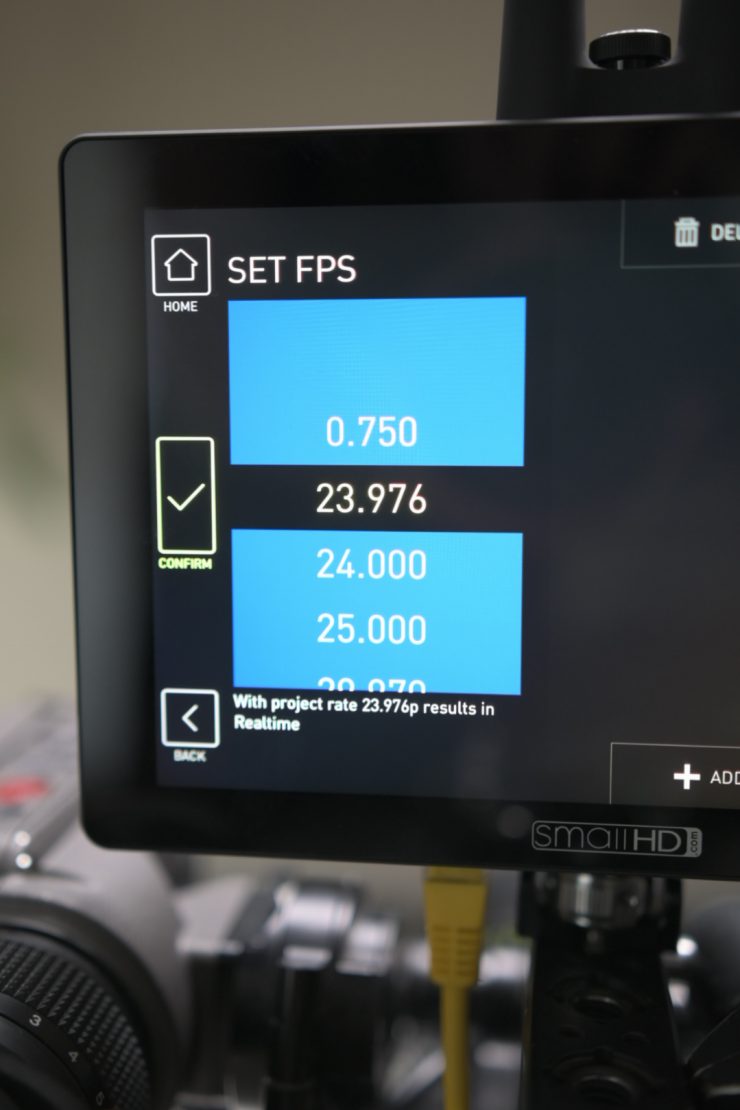
I wanted to see if you could still access the web browser or the Pomfort Pocket Control while using the ethernet with the Cine 7. I found that you could use both at the same time without any problem.
Free ARRI Camera Control until May 19
Currently, SmallHD is running a promotion until May 19 (PST), where if you purchase any monitor from the Cine 7 range, you will receive the $500 USD ARRI Camera Control license for free.
A future control center?
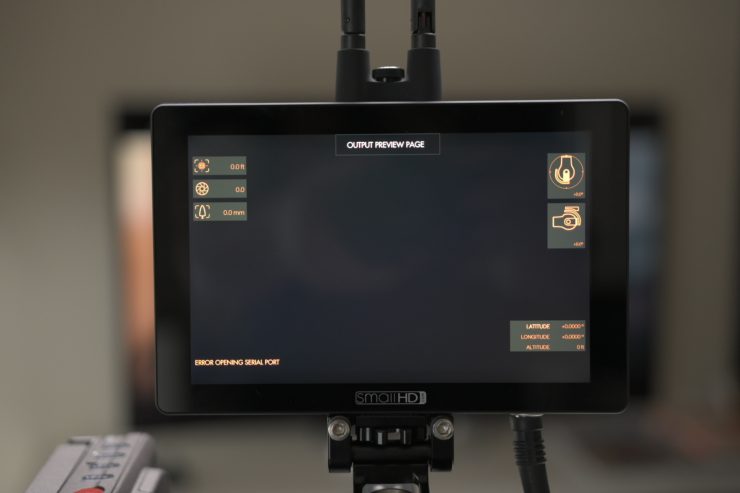
As well as camera control, the Cine 7 already supports Shotover systems. No additional licensing is needed, you only require a Shotover device to add the overlays. Currently, the M1 & G1 are supported with F1 support coming soon.
Teradek RT Overlays are supported as well, and the licensing on the RT controller is all that is needed to support those.
What is exciting about the Cine 7 is what is yet to come. SmallHD has big plans for the Cine 7 moving forward. Their ultimate aim is to make the Cine 7 a rugged, versatile video monitoring, connectivity, and control central interface on a film set.
SmallHD is going to try and support all cameras. SmallHD says that they can use a serial port adapter accessory which Ryan Schorman (Wooden Camera) is developing. This way if the camera doesn’t have Ethernet you will still be able to do camera control.
What isn’t clearly known is that the Cine 7 already has Bluetooth onboard which will theoretically allow it to connect to cameras that have Bluetooth control. In addition, SmallHD wants to add support for other devices on-screen. This includes DJI drones and their HUD with all flight information. Freefly and DJI gimbals could also actually be controlled by the monitor or at least provide status information. SmallHD also wants to support lighting packages in the same way that ARRI SkyPanels or Litepanels uses a versatile iOS app.
Wireless functionality
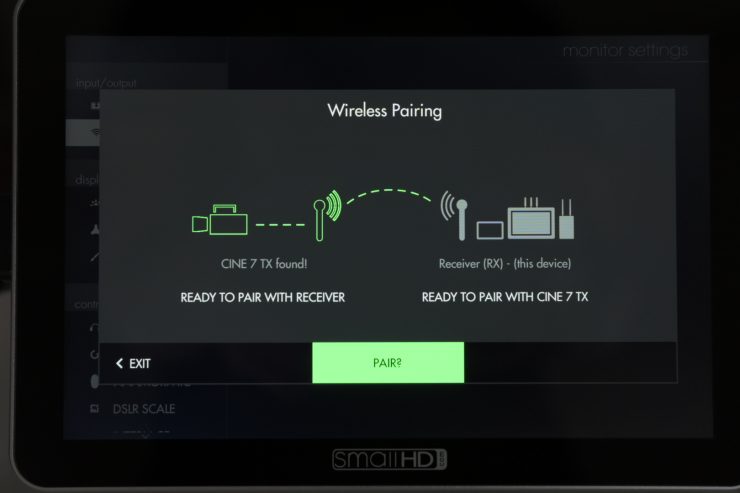
This built-in Transmitter has a claimed range of up to 500′ line of sight (or 500′
If you are going to build a wireless receiver into a monitor then it needs to be not only reliable but also trouble-free. Pairing is required with the Cine 7 otherwise, anybody with one could show up on set and steal your footage. The pairing process encrypts the transmission, which keeps everything secure and available only to those people you want to see the footage.
The nice thing about the built-in Bolt wireless receiver is that it is fairly easy to pair up with a Bolt transmitter or the Cine 7 TX. This can be done directly from
I like that once you have paired your transmitter once with the Cine 7 RX, all you need to do is turn it on and it just automatically connects up instantly.
To pair the product, you could also use the Bolt Manager software.
Wireless performance
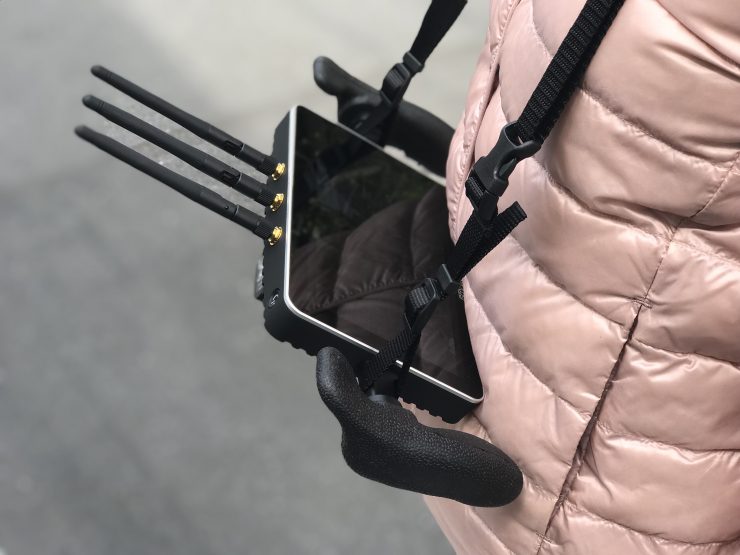
This is always a hard one to review and test. Wireless range and performance depend on where you are using it. In one location you may get 500′ of range or more, and in another, you may be lucky to get 50′. From my testing here in Japan, I found the wireless range to be pretty good. I managed to get a perfectly stable signal even when I left the transmitter in my apartment and then went down two flights of stairs, around a corner, down a corridor and then went outside the building. I was impressed as there was no direct line of sight and an awful lot of concrete and steel between the transmitter and receiver.
To further test the range I set up a test where I could measure the exact distance at which the Cine 7 500 TX
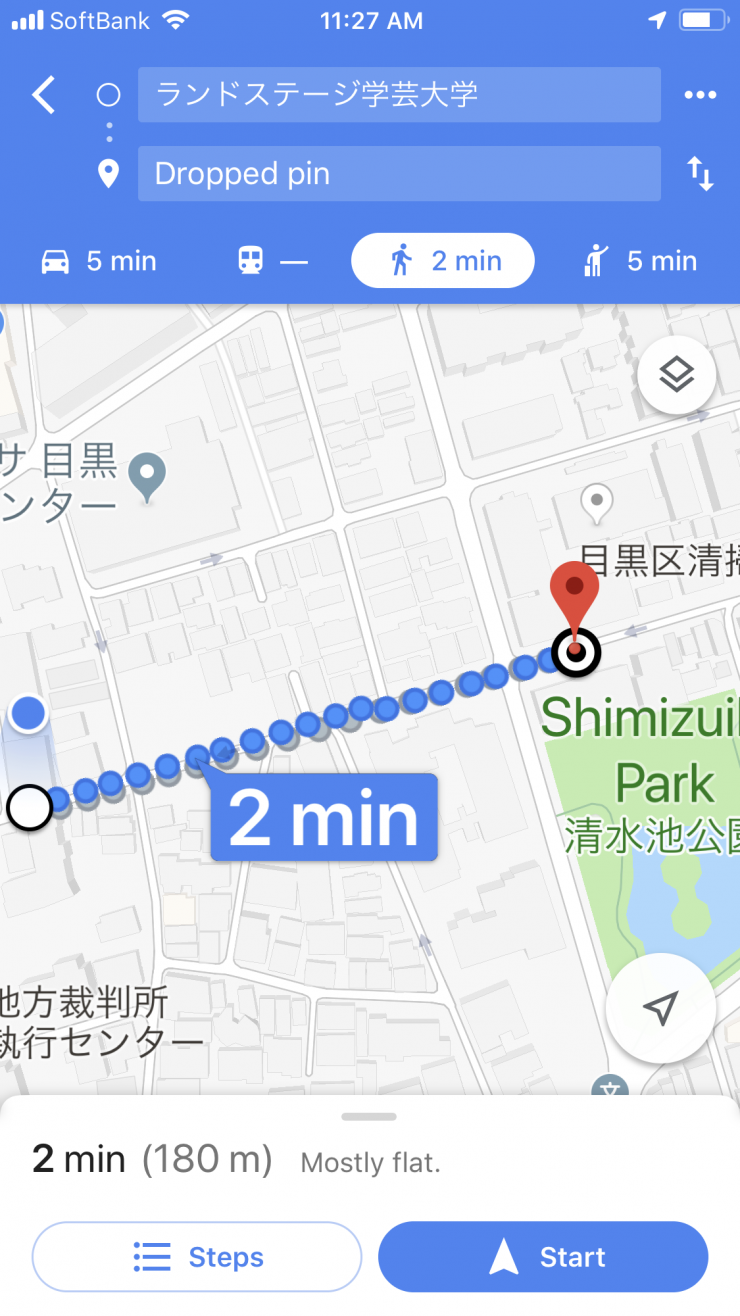
I found that I still had a good clean, stable signal up until around 180m (590ft) from where the camera was as long as I maintained a
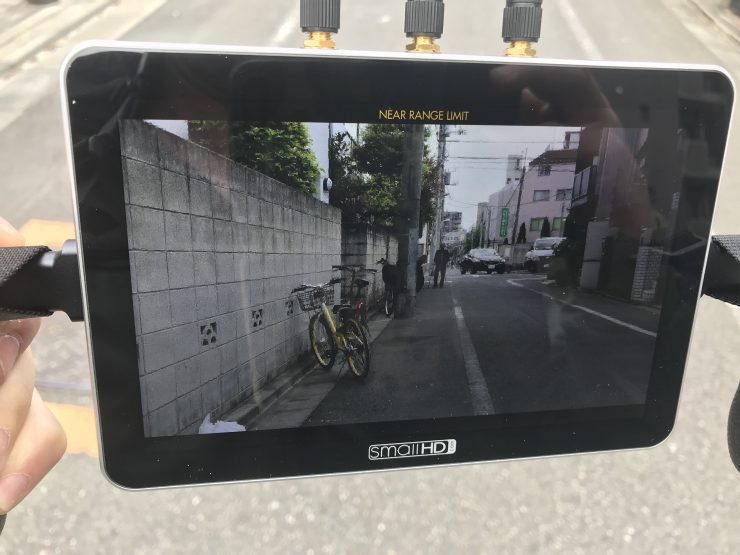
What is nice is that the Focus 7 Bolt 500 RX actually gave me warnings on the screen when I started to approach its maximum operating range.
Once the Focus 7 Bolt 500 RX dropped the signal this is where I ran into problems. I found that even when I started walking back towards the camera the signal didn’t return. I even tried turning the RX unit off and on again but that didn’t work either. I found that I had to walk all the way back to within around 10m of the TX unit for the signal to come back. This is one of the frustrating things when using wireless, it’s never really bulletproof.
While the range of the system was good I wanted to see what would happen if I lost connection, so I turned the receiver off and then back on again. It took roughly 8 seconds for the receiver to re-establish a connection which was reasonably quick.
Next, I turned the transmitter off, which is more commonly what may happen when you change over a camera battery or power the camera off and then on again. This time it took around 11 seconds for the picture to re-establish.
What about if I pulled out the SDI from the camera? This time the system re-established connection in around 7 seconds.
So what would happen if I suddenly changed the frame rate to 60fps (still in a 23.98p recording mode) on my camera while the system was on? I lost the picture for about 3 seconds. When I changed the camera back to 23.98fp, it took around 5 seconds for the picture to re-establish.
Now, SmallHD claims the Cine 7 will support up to 60p in full HD, so I decided to test that claim. Again this was no problem at all, and changing from 23.98p to 60p didn’t result in a loss of picture at all.
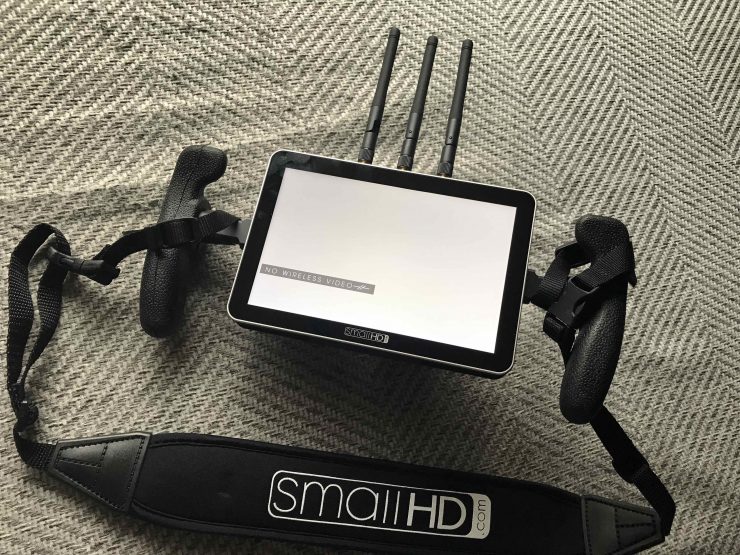
The problem was that once I changed my camera to 60p the picture was there on the Cine 7 TX, but I couldn’t get a picture on the Focus 7 Bolt 500 RX.
Power Draw
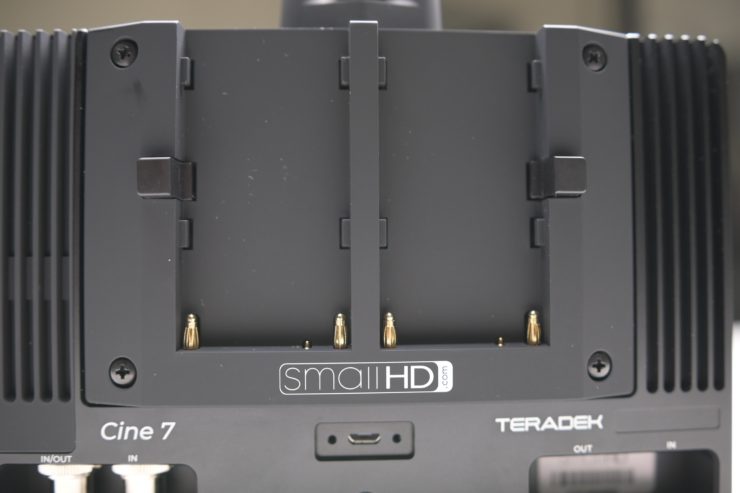
With a 1,800 nit daylight viewable screen and built-in wireless receiver (or transmitter), the Cine 7 500 TX consumes a maximum of 18.2 watts (2160p30, 100% brightness, tools enabled). This does make it fairly power hungry for a small device. 18.2 watts is more than the 16 watts that is consumed by the brighter 703 Bolt.
The power input for the device is 10V-34V. SmallHD recommends that us a DC 12~15V at ~2.5 amp or greater when powering the Cine 7 TX.
I found that I could run the system off two Anton Bauer NP-F774 batteries. for around 3-3.5 hours. The battery plate is removable and can be swapped over for a V-mount or AB-Gold Mount plate.
LUTS
The Cine 7 comes with a range of pre-configured LUTS already installed, but you can load up your own LUTs to use as well. This is a fairly easy process and you just need to load them up onto an SD card.
What I like is that you aren’t just limited to being able to load up a handful of LUTs. You can load up and store as many as you like.
Headphone Jack

The Cine 7 does have a headphone jack that is located on top of the unit. Unfortunately, it is positioned right next to the SD card slot and you need to take a protective rubber cover off to use it. The rubber cover doesn’t stay attached and it just come s straight off. This is going to be easily lost.
As far as what you can monitor from the headphone jack you don’t get any options apart from a headphone volume level. If you are recording two channels of audio that audio is mixed and sent through both the right and left headphones. This makes it impossible to monitor or just listen to just one channel of audio if you are using it for playback.
This may seem like trivial things, but it’s something you need to take into consideration if you are going to use headphones with the Cine 7.
Is it a disadvantage having the wireless built in?
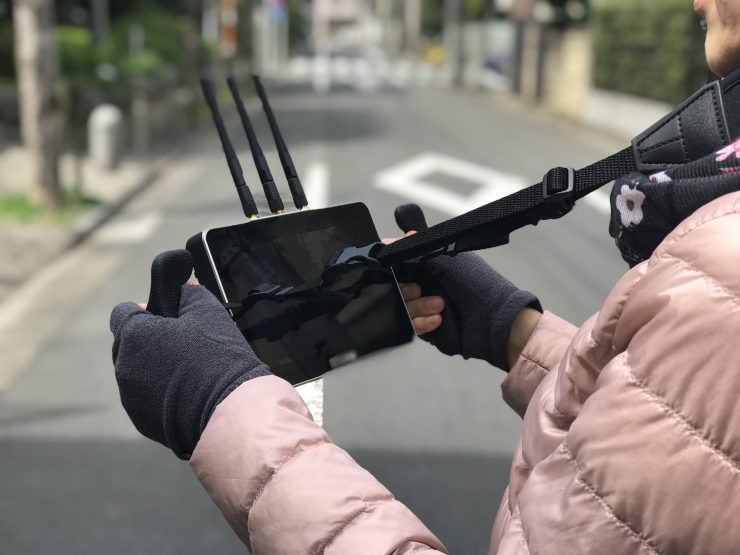
This is a question a lot of people are bound to ask, so I’ll address it from my perspective. No, I don’t think it is a disadvantage having it built-in, and here is why. The Bolt wireless receiver doesn’t make the Cine 7 RX much bigger than a FOCUS 7 On-Camera Monitor, and even if you don’t want to use the wireless capabilities it’s not going to get in the way.
Could Teradek and SmallHD just have made a detachable or slot in a wireless receiver? I asked Teradek about this and I was told that “Regarding detachable wireless receivers, this is something we’re actively looking into. Our goal is to make these integrated solutions as lightweight and as small as possible while maintaining an affordable price point.”
This however, got me thinking. As there is both a Cine 7 TX and a RX, why couldn’t SmallHD and Teradek have made a system where you could interchange modules. For instance if you wanted to use the Cine 7 TX on your camera as a monitor and transmiiter but then wanted to turn it into a wireless receiver wouldn’t it be nice to just be able to take out a wireless TX and slip in a wireless reveiver?
Having modular wireless TX and RX units that could be interchanged into the Cine 7 or used as stand alone TX or RX units would make a lot of sense.
HDR?
Something that SmallHD hasn’t incorporated into any of their monitors that are under 13″ is HDR.
While the Cine 7 reaches 1,800 Nits, it doesn’t do so dynamically as to technically meet the HDR spec (for contrast ratio). However, it can still be used to monitor HDR.
According to SmallHD, their view is that on the monitoring side, relying on the picture alone, even a true HDR picture in anything other than a studio environment is not ideal and would result in improper exposure adjustments since the perceptions of what is on screen changes so drastically along with the viewing environment. For example, if monitoring on a bright sunny day, any subtleties in the darkest areas of an HDR picture will be completely lost to the eye and may not be accounted for – in this case, you actually would want a boosted black point so that issues can be spotted due to the environmental constraints.
In this methodology, reliance on exposure tools and scopes is even more important than before when speaking of HDR because, in a proper viewing environment, any issues at the extremes of a camera’s dynamic range get magnified much further than with SDR.
When people ask how to best shoot for HDR, SmallHD normally recommends using a waveform set to RGB or parade (so if one individual color channel gets clipped you can pick it up before the luma waveform would see the same issue) or to set a custom exposure assist (false color) to the points in the image where clipping occurs. If shooting in log and at least 10-bit (12 bit+ preferred) and the extremes of the exposure range are managed, you’ll be capturing future-proof HDR-ready material. Now what to do with that footage next is a whole new issue with all the competing standards, and a surge of HDR10+ across manufacturers, etc. help demystify for the shooter while treading carefully not to further complicate this already complicated world.
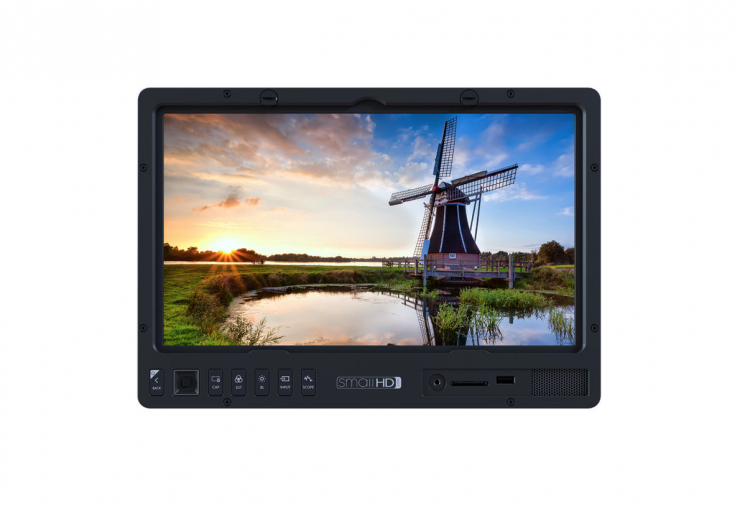
SmallHD has employed some HDR previewing tools into their production monitors which apply the PQ curve to Log signals but they intend to make it even more user-friendly going forward.
HDR is far from any sort of fad, the benefits are tremendous when it comes to giving creative control back to the filmmakers and when taken seriously it means the picture will be exactly how it is determined by creatives — as it should be.
Collaboration
Both SmallHD and Teradek fall under the Vitec umbrella and it’s good to see technology from two different brands being integrated into a single product. From my understanding, one of the main reasons that Vitec was acquiring all of these different brands was so that they could share the technology and come up with better products. It certainly has taken some time for this to happen.
Given the fact that Teradek just announced the 4K Bolt at NAB, I think it would be fair to assume that at some point tint time we will probably see a SmallHD monitor with an in-built 4K Bolt.
Price
Here are the prices for the various models that are available:
- Cine 7 – $1,799 USD (ships in April)
- Cine 7 500 TX – $2,749 USD (ships in May)
- Cine 7 500 RX – $2,749 USD (ships in May)
- Cine 7 Sidekick RX – $3,699 (ships in May)
- ARRI Camera Control License – $500 USD – SmallHD is currently including the ARRI Camera Control License for free until May 19.
If you are a little bit confused by what the differnce is between the 500RX and the Sidekick RX, I’ll expalin it for you.
- The MON-Cine7-500-RX features the built-in Teradek Bolt 500 Receiver (The Bolt 500 works solely with Bolt 500 Transmitters)
- The MON-Cine7-SK-RX features the built-in Teradek Bolt Sidekick Receiver (The Sidekick works with Bolt 500, 1000, 3000 Transmitters — still only operating at the 500 feet line of sight, but can communicate with the longer distance transmitters.)
This is not exactly what I would classify as affordable, but you are getting a lot of functionality and features for your money. The nice thing about all of the Teradek products is that the majority of them are backward compatible so something you buy today will still work with something old, and probably something that is still yet to be released.
For me personally, the Cine 7 RX and TX make a lot more sense than the Cine 7. If you are just looking for a monitor and not one with a built-in wireless transmitter or receiver, then there are certainly more affordable options out there.
What you also need to take into account is that the Cine 7 500 TX doesn’t come with a receiver, and the Cine 7 500 RX doesn’t come with a transmitter. The cheapest compatible option; the Bolt 500 XT is $1,390 USD. So realistically you’re looking at $4,139 USD for a system. If you already own a Bolt transmitter then you won’t need to spend that additional cash.
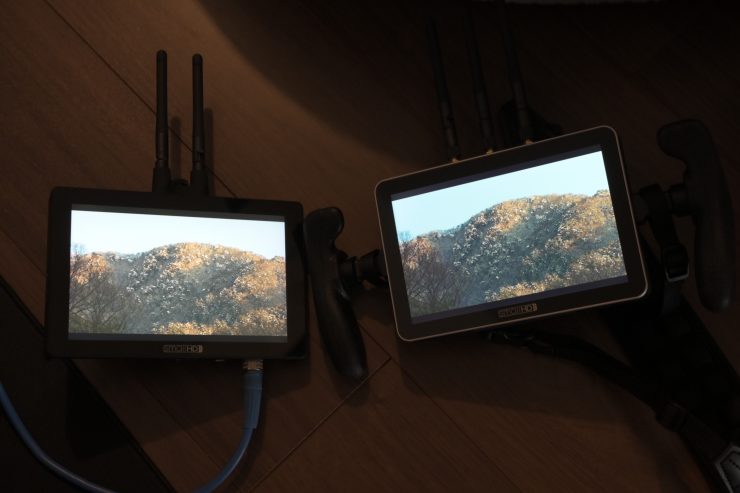
Another option is to mix and match systems. You could for example, go with a Cine 7 TX and pair it with a Focus 7 RX.
Competition
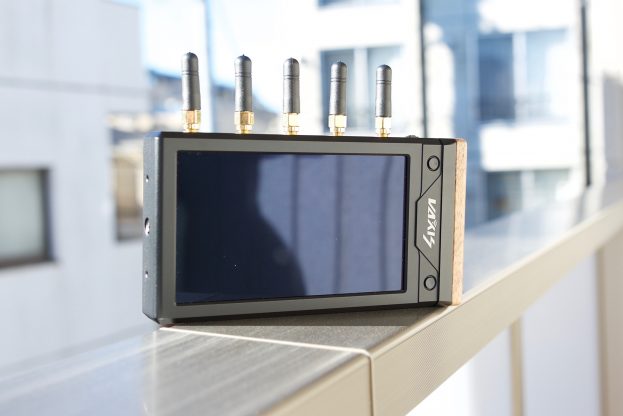
Nobody else makes an integrated 7″ wireless monitor/receiver except for SmallHD themselves. The closest product that could offer competition is the Vaxis Storm 058 Focus which I have previously reviewed.
The Vaxis Storm 058 Focus has a built-in Storm 1000FT+ Wireless Receiver with a full HD (1920×1080) IPS 5.8″ screen and claimed 1,000 nits of brightness. I measured the screen and it only had 737 nits.
The Vaxis Storm 058 Focus retails for $2,599 USD without a TX unit. This is expensive considering the unit has no inputs and a serious lack of monitoring assist tools. The SmallHD Cine 7 500 RX is a vastly superior product when compared against the Vaxis Storm 058. The only advantage the Vaxis has is transmission distance.
Conclusion
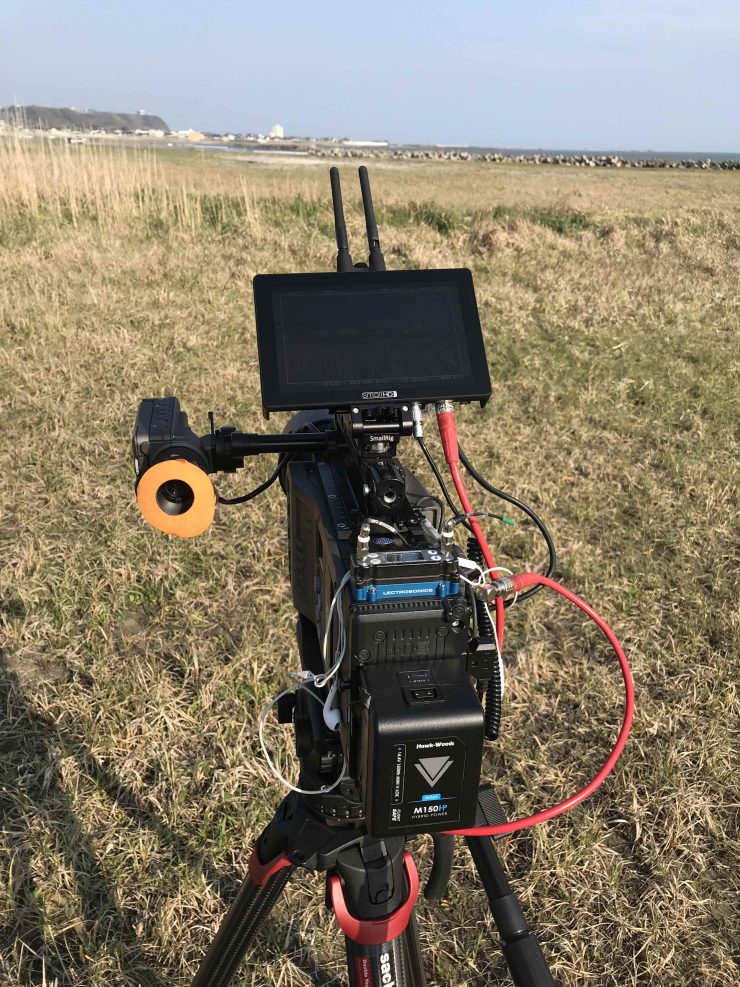
It’s not that hard to come up with a reasonably good looking screen these days and be able to sell it for a few hundred dollars. The problem is there is a lot more to a monitor than just the display. It’s the software and the OS that separates the good and great monitors from the ok ones.
Sure you could go and grab a pretty decent 5″ or 7″ monitor for under $300 USD, but have a good close look at its monitoring tools and operating system. Most so-called “affordable” monitors leave a lot to be desired on this front.
At the end of the day, a monitor or an EVF is how we judge everything we shoot. Why on earth would you not want to use the best possible option you can afford. A good chef isn’t going to buy an expensive oven and then throw a frozen pizza in there and expect it to taste like a freshly made one using quality ingredients. Do you really want to use the equivalent of a frozen pizza as your sole monitoring option?
The Cine 7 a nice bit of kit and it delivers on its intended purpose. It’s functional and easy to use, and to me, that’s the mark of a good product. The build quality is very good and the operating system is intuitive and well thought out. The only real downside to the Cine 7 is the heat that it produces. I have made SmallHD aware of this and they are trying to reduce the amount of heat the Cine 7 units produce before the product starts to ship.
The fact that the Cine 7 can essentially replace three separate devices (a monitor, a wireless transmitter or receiver, and a smartphone or tablet for camera control) certainly makes it an interesting proposition. With future control for other devices in the works, it’s a product that should continue to evolve over time. I’m not a big fan of companies charging for licenses to add features and functionality, but unfortunately, that’s what SmallHD is doing.
If you are looking for a versatile product that can be used as both an on-camera monitor and a wireless transmitter or receiver (depending on whether you have the TX or RX version) then the SmallHD Cine 7 is certainly worth taking a hard look at. With the added benefit of camera control (albeit at a cost) and one of the best images I have seen from any SmallHD product, the Cine 7 TX is a nice piece of kit that solves a lot of real-world problems.

